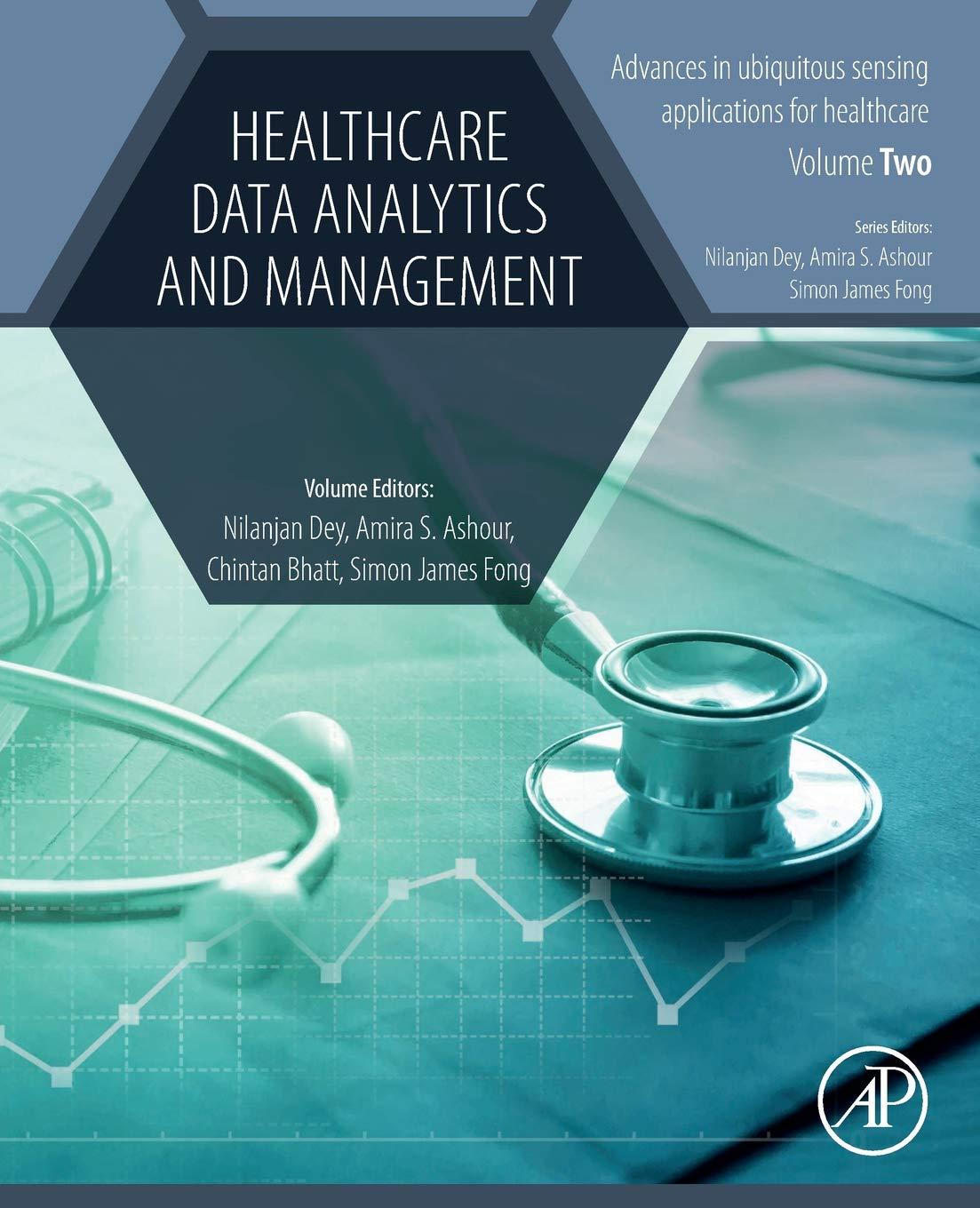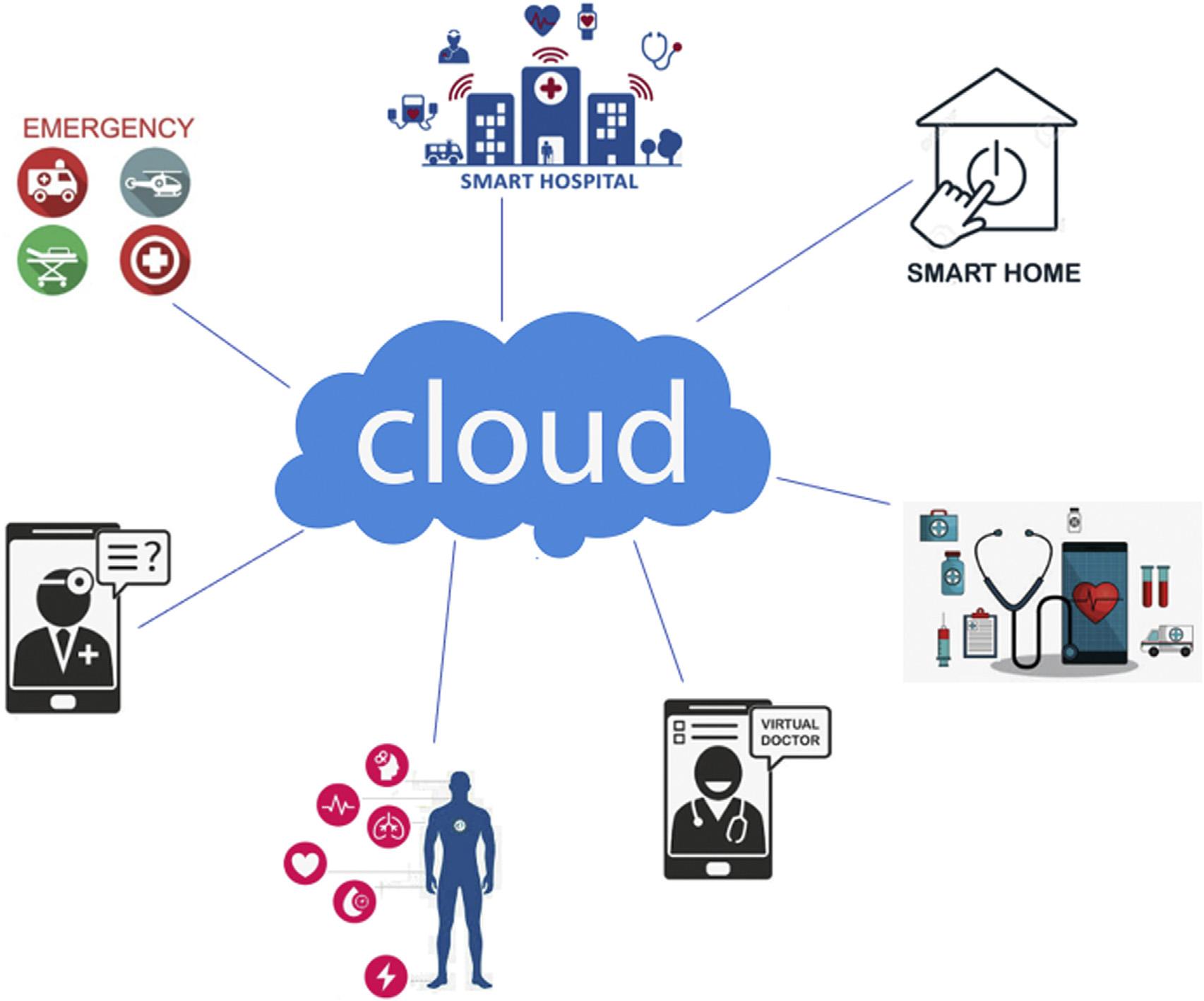Translational Bioinformatics in Healthcare and Medicine (Volume 13) (Advances in ubiquitous sensing applications for healthcare, Volume 13) 1st Edition
Visit to download the full and correct content document: https://ebookmeta.com/product/translational-bioinformatics-in-healthcare-and-medicin e-volume-13-advances-in-ubiquitous-sensing-applications-for-healthcare-volume-13-1 st-edition/
More products digital (pdf, epub, mobi) instant download maybe you interests ...
Healthcare Data Analytics and Management Advances in ubiquitous sensing applications for healthcare 1st Edition Nilanjan Dey (Editor)
https://ebookmeta.com/product/healthcare-data-analytics-andmanagement-advances-in-ubiquitous-sensing-applications-forhealthcare-1st-edition-nilanjan-dey-editor/
Electrocardiography for Healthcare Professionals, 6e (Oct 13, 2023)_(1266092013)_(McGraw Hill).epub 6th Edition Kathryn Booth
https://ebookmeta.com/product/electrocardiography-for-healthcareprofessionals-6e-oct-13-2023_1266092013_mcgraw-hill-epub-6thedition-kathryn-booth/
Translational Bioinformatics and Systems Biology Methods for Personalized Medicine 1st Edition Qing Yan
https://ebookmeta.com/product/translational-bioinformatics-andsystems-biology-methods-for-personalized-medicine-1st-editionqing-yan/
Bio Nano Interface Applications in Food Healthcare and Sustainability
https://ebookmeta.com/product/bio-nano-interface-applications-infood-healthcare-and-sustainability/
Deep Learning and IoT in Healthcare Systems: Paradigms and Applications 1st Edition
https://ebookmeta.com/product/deep-learning-and-iot-inhealthcare-systems-paradigms-and-applications-1st-edition/
Advances in Smart Healthcare Paradigms and Applications
Outstanding Women in Healthcare Volume 1 Halina
Kwa■nicka Nikhil Jain Urszula Markowska Kaczmar Chee
Peng Lim Lakhmi C Jain Eds
https://ebookmeta.com/product/advances-in-smart-healthcareparadigms-and-applications-outstanding-women-in-healthcarevolume-1-halina-kwasnicka-nikhil-jain-urszula-markowska-kaczmarchee-peng-lim-lakhmi-c-jain-eds-2/
Advances in Smart Healthcare Paradigms and Applications
Outstanding Women in Healthcare Volume 1 Halina
Kwa■nicka Nikhil Jain Urszula Markowska Kaczmar Chee
Peng Lim Lakhmi C Jain Eds
https://ebookmeta.com/product/advances-in-smart-healthcareparadigms-and-applications-outstanding-women-in-healthcarevolume-1-halina-kwasnicka-nikhil-jain-urszula-markowska-kaczmarchee-peng-lim-lakhmi-c-jain-eds/
Advanced Computing and Systems for Security Volume 13 1st Edition Rituparna Chaki
https://ebookmeta.com/product/advanced-computing-and-systems-forsecurity-volume-13-1st-edition-rituparna-chaki/
Artificial Intelligence for Healthcare Applications and Management 1st Edition Boris Galitsky
https://ebookmeta.com/product/artificial-intelligence-forhealthcare-applications-and-management-1st-edition-borisgalitsky/
ADVANCESINUBIQUITOUSSENSING APPLICATIONSFORHEALTHCARE13
TranslationalBioinformatics inHealthcareandMedicine Volume13
Editedby KhalidRaza AssistantProfessor,DepartmentofComputerScience, JamiaMilliaIslamia(CentralUniversity),India
NilanjanDey AssociateProfessor,JISUniversity,Kolkata,India
SeriesEditors
NilanjanDey
AmiraS.Ashour
SimonJamesFong
AcademicPressisanimprintofElsevier 125LondonWall,LondonEC2Y5AS,UnitedKingdom
525BStreet,Suite1650,SanDiego,CA92101,UnitedStates
50HampshireStreet,5thFloor,Cambridge,MA02139,UnitedStates TheBoulevard,LangfordLane,Kidlington,OxfordOX51GB,UnitedKingdom
Copyright © 2021ElsevierInc.Allrightsreserved.
Nopartofthispublicationmaybereproducedortransmittedinanyformorbyanymeans,electronicormechanical,including photocopying,recording,oranyinformationstorageandretrievalsystem,withoutpermissioninwritingfromthePublisher. Detailsonhowtoseekpermission,furtherinformationaboutthePublisher’spermissionspoliciesandourarrangementswith organizationssuchastheCopyrightClearanceCenterandtheCopyrightLicensingAgency,canbefoundatourwebsite: www.elsevier.com/permissions
ThisbookandtheindividualcontributionscontainedinitareprotectedundercopyrightbythePublisher(otherthanasmay benotedherein).
Notices
Knowledgeandbestpracticeinthis fieldareconstantlychanging.Asnewresearchandexperiencebroadenourunderstanding, changesinresearchmethods,professionalpractices,ormedicaltreatmentmaybecomenecessary.
Practitionersandresearchersmustalwaysrelyontheirownexperienceandknowledgeinevaluatingandusingany information,methods,compounds,orexperimentsdescribedherein.Inusingsuchinformationormethodstheyshouldbe mindfuloftheirownsafetyandthesafetyofothers,includingpartiesforwhomtheyhaveaprofessionalresponsibility.
Tothefullestextentofthelaw,neitherthePublisher,northeauthors,contributors,oreditors,assumeanyliabilityforany injuryand/ordamagetopersonsorpropertyasamatterofproductsliability,negligenceorotherwise,orfromanyuseor operationofanymethods,products,instructions,orideascontainedinthematerialherein.
LibraryofCongressCataloging-in-PublicationData
AcatalogrecordforthisbookisavailablefromtheLibraryofCongress
BritishLibraryCataloguing-in-PublicationData
AcataloguerecordforthisbookisavailablefromtheBritishLibrary
ISBN:978-0-323-89824-9
ForinformationonallAcademicPresspublicationsvisitourwebsiteat https://www.elsevier.com/books-and-journals
Publisher: StacyMasucci
SeniorAcquisitionsEditor: RafaelE.Teixeira
SeniorEditorialProjectManager: SusanIkeda
ProductionProjectManager: NiranjanBhaskaran
CoverDesigner: MatthewLimbert
TypesetbyTNQTechnologies
JamiaMilliaIslamia(CentralUniversity),NewDelhi(India),completed100yearsonOctober29,2020.Ontheoccasion ofthecentenarycelebration, thisvolumeisdedicatedtoallthefounders,forefathers,teachers,researchers,students, staff,andotherstakeholdersofJamiaMilliaIslamiafortheirselflessandvaluablecontributions
Contributors KayodeI.Adenuga,FacultyofEnterprise,Creativeand ProfessionalStudies,FarnboroughCollegeofTechnology,Hampshire,UnitedKingdom
NadiaAhmad,DepartmentofBiotechnologyandBioinformatics,JaypeeUniversityofInformationTechnology,Waknaghat,HimachalPradesh,India
SalimAhmad,DepartmentofComputerScience,Jamia MilliaIslamia,NewDelhi,Delhi,India
NaeemAhmad,DepartmentofComputerApplications, MadanapalleInstituteofTechnologyandScience, Madanapalle,AndhraPradesh,India
ShabanAhmad,DepartmentofComputerScience,Jamia MilliaIslamia,NewDelhi,Delhi,India
SarraAkermi,AnnotationsAnalyticsPvtLtd.,Gurgaon, Haryana,India
AfrojAlam,DepartmentofComputerApplication,IntegralUniversity,Lucknow,UttarPradesh,India
MdTauseefAlam,DepartmentofComputerScience, JamiaMilliaIslamia,NewDelhi,Delhi,India
RangelArthur,FacultyofTechnology(FT),StateUniversityofCampinas(UNICAMP),Limeira,SãoPaulo, Brazil
RejaulKarimBarbhuiya,NationalCouncilofEducationalResearchandTraining,NewDelhi,Delhi,India
AnamBeg,DepartmentofComputerScience,JamiaMillia Islamia,NewDelhi,Delhi,India
RubinaChongtham,DepartmentofBotany,Deshbandhu College,UniversityofDelhi,NewDelhi,Delhi,India
MohinikantiDas,DepartmentofBotany,CollegeofBasic Science&Humanities,OrissaUniversityofAgriculture andTechnology,Bhubaneswar,Odisha,India
RutumbaraDash,SchoolofLifeSciences,Sambalpur University,Burla,Odisha,India
ReinaldoPadilhaFrança,SchoolofElectricalEngineeringandComputing(FEEC),StateUniversityofCampinas(UNICAMP),Campinas,SãoPaulo,Brazil
EktaGandotra,DepartmentofComputerScience& EngineeringandInformationTechnology(CSE&IT),
JaypeeUniversityofInformationTechnology,Waknaghat,HimachalPradesh,India
E.J.Garba,ComputerScienceDepartment,Modibbo AdamaUniversityofTechnology,Yola,Adamawa State,Nigeria
A.B.Garko,ComputerScienceDepartmentFederalUniversityDutse,JigawaState,Nigeria
RajeshKumarGazara,LaboratóriodeQuímicaeFunção deProteínasePeptídeos,CentrodeBiociênciaseBiotecnologia,UniversidadeEstadualdoNorteFluminense DarcyRibeiro,CamposdosGoytacazes,RiodeJaneiro, Brazil
ArabindaGhosh,DepartmentofBotany,GuwahatiUniversity,Assam,Guwahati,India
YuzoIano,SchoolofElectricalEngineeringandComputing(FEEC),StateUniversityofCampinas(UNICAMP),Campinas,SãoPaulo,Brazil
NorSyahidatulNadiahIsmail,FacultyofComputing, UniversitiMalaysiaPahang,Pekan,Pahang,Malaysia
SunilJayant,AnnotationsAnalyticsPvtLtd.,Gurgaon, Haryana,India
SurabhiJohari,SchoolofBiosciencesInstituteofManagementStudiesGhaziabad(UniversityCourses),Uttar Pradesh,India
G.R.Karpagam,PSGCollegeofTechnology,Coimbatore,TamilNadu,India
FatimaNazishKhan,DepartmentofComputerScience, JamiaMilliaIslamia,NewDelhi,Delhi,India
LaxmanKumar,DepartmentofBotany,JamiaHamdard, NewDelhi,Delhi,India
NarendraKumar,DepartmentofBiotechnologyand Bioinformatics,JaypeeUniversityofInformation Technology,Waknaghat,HimachalPradesh,India
MeetKumari,DepartmentofElectronicsandCommunicationEngineering,PunjabiUniversity,Patiala,Punjab, India
AinaUmairahMazlan,FacultyofComputing,Universiti MalaysiaPahang,Pekan,Pahang,Malaysia
PiyusMohanty,DepartmentofBiotechnologyand Bioinformatics,JaypeeUniversityofInformation Technology,Waknaghat,HimachalPradesh,India
AnaCarolinaBorgesMonteiro,SchoolofElectrical EngineeringandComputing(FEEC),StateUniversity ofCampinas(UNICAMP),Campinas,SãoPaulo, Brazil
L.J.Muhammad,MathematicsandComputerScience Department,FederalUniversityofKashere,Gombe State,Nigeria
N.D.Oye,ComputerScienceDepartment,Modibbo AdamaUniversityofTechnology,Yola,Adamawa State,Nigeria
ManasaKumarPanda,SchoolofLifeSciences, SambalpurUniversity,Burla,Odisha,India;Environment&SustainabilityDepartment,CSIR-IMMT, Bhubaneswar,Odisha,India
RafatParveen,DepartmentofComputerScience,Jamia MilliaIslamia,NewDelhi,Delhi,India
SaharQazi,DepartmentofComputerScience,Jamia MilliaIslamia,NewDelhi,Delhi,India
AyyagariRamlal ,DepartmentofBotany,Universityof Delhi,NewDelhi,Delhi,India
IsmailRashid,ComputerScienceFaculty,BakhtarUniversity,Kabul,Afghanistan
KhalidRaza,DepartmentofComputerScience,Jamia MilliaIslamia,NewDelhi,Delhi,India
MuhammadAkmalRemli,InstituteforArtifi cialIntelligenceandBigData,UniversitiMalaysiaKelantan,Kota Bharu,Kelantan,Malaysia;DataScienceDepartment, UniversitiMalaysiaKelantan,KotaBharu,Kelantan, Malaysia
NoorAzidaSahabudin,FacultyofComputing,Universiti MalaysiaPahang,Pekan,Pahang,Malaysia
AbhishekSahu,SchoolofLifeSciences,Sambalpur University,Burla,Odisha,India
ReechaSharma,DepartmentofElectronicsandCommunicationEngineering,PunjabiUniversity,Patiala,Punjab,India
AshwaniSharma,ComputationalCentre,Rennes,France
AnuSheetal,DepartmentofElectronicsandCommunicationEngineering,GuruNanakDevUniversity,Gurdaspur,Punjab,India
YengkhomDiscoSingh,DepartmentofPostHarvest Technology,CollegeofHorticultureandForestry, CentralAgriculturalUniversity,Pasighat,Arunachal Pradesh,India
SubrataSinha,CentreforBiotechnologyandBioinformaticsDibrugarhUniversity,Assam,Dibrugarh, India
P.Sivakumar,PSGCollegeofTechnology,Coimbatore, TamilNadu,India
S.Sridevi,PSGCollegeofTechnology,Coimbatore, TamilNadu,India
SandhyaVerma,ShriVaishnavInstituteofScience,Shri VaishnavVidyapeethVishwavidyalaya,Indore,MadhyaPradesh,India
B.VinothKumar,PSGCollegeofTechnology,Coimbatore,TamilNadu,India
S.Vishnuvardhan,PSGCollegeofTechnology,Coimbatore,TamilNadu,India
G.M.Wajiga,ComputerScienceDepartment,Modibbo AdamaUniversityofTechnology,Yola,Adamawa State,Nigeria
AbouttheEditors KhalidRaza isanassistantprofessorattheDepartmentofComputerScience,JamiaMillia Islamia(CentralUniversity),NewDelhi.Dr.Razahasbeenhonoredwith “ICCRChair VisitingProfessor” bytheIndianCouncilforCulturalRelation(ICCR),MinistryofForeignAffairs,GovernmentofIndia,anddeputedatthefacultyofComputerandInformation Sciences,AinShamsUniversity,Cairo,Egypt.Hehasover10yearsofteachingand researchexperienceinthe fieldoftranslationalbioinformaticsandcomputationalintelligenceapplicationsinhealthcare.Hehascontributedover70researcharticlesinreputed journalsandeditedbooks.Hehasauthoredandeditedbookswithreputedpublishers.He hasreviewedover150researcharticlesforreputedjournalsandconferencesinthelast 5years.Dr.Razahasdeliveredseveralkeynoteaddresses,invitedtalks,publiclectures, andseminarsinnationalandinternationalconferences,workshops,andchairedtechnical sessionsatvariousconferences.Hehasservedasthetechnicalprogramcommitteemember ofseveralinternationalconferencesandworkshops.HehasalsoexecutedtwoIndian government-fundedresearchprojects.Dr.Razaisamemberofseveralprofessionalbodies. Hisresearchinterestsincludetranslationalbioinformatics,computationalintelligence methods,andapplicationsinbioinformaticsandhealth-informatics.
NilanjanDey isanassociateprofessor,DepartmentofComputerScienceandEngineering,JISUniversity,Kolkata,India.HeisavisitingfellowoftheUniversityofReading, UK.HewasanhonoraryvisitingscientistatGlobalBiomedicalTechnologies,Inc.,CA, USA(2012 15).HewasawardedhisPhDfromJadavpurUniversityin2015.Hehas authoredandeditedmorethan70bookswithElsevier,Wiley,CRCPress,andSpringer, andpublishedmorethan300papers.HeistheeditorinchiefoftheInternationalJournalof AmbientComputingandIntelligence,IGIGlobal,associatededitorofIEEEAccess,and InternationalJournalofInformationTechnology,Springer.Heistheseriesco-editorof SpringerTractsinNature-InspiredComputing,Springer,seriesco-editorofAdvancesin UbiquitousSensingApplicationsforHealthcare,Elsevier,andserieseditorofComputationalIntelligenceinEngineeringProblemSolvingandIntelligentSignalProcessingand DataAnalysis,CRC.Hismainresearchinterestsincludemedicalimaging,machine learning,computer-aideddiagnosis,datamining,etc.HeistheIndianambassadorofthe InternationalFederationforInformationProcessing,YoungICTGroup,andsenior memberofIEEE.
Preface Modernbiologicexperiments,includinghigh-throughputmeasurementtechniquessuchasnext-generationsequencingand microarraytechnologies,havegeneratedmassiveamountsofbiologicdata,givingrisetovariousbiologicdatabases.These databasesarevaluableresourcesandtoolsforvariousstakeholdersincludingbutnotlimitedtobiologists,clinicians, bioinformaticians,andhealthcareprofessionals.Translationalbioinformaticsisanemerging fieldofstudiesthatinvolves thedevelopmentofstorage,analytics,andsophisticatedcomputationalmethodstotransformvoluminousbiomedicaldata intoproactive,predictive,preventative,andparticipatoryhealthcare.The finalproductoftranslationbioinformaticsis newlydiscoveredknowledgethatcanbedisseminatedtoavarietyof fi eldsincludinghealthcareandmedicine.Further,in theeraofinterdisciplinaryandmultidisciplinarysciences,suchasbio-informatics,chemo-informatics,health-informatics, viro-informatics,drug-informatics,andsoon,itisdif ficultforthetargetaudienceto findasingleresourcecoveringvarious aspectsofinformaticsrelatedtohealthcareandmedicine.
TranslationalBioinformaticsinHealthcareandMedicine,partoftheAdvancesinUbiquitousSensingApplication forHealthcareseries,offersadetailedoverviewoftranslationalbioinformatics,translationalmedicineinhealthcare, precisionmedicineandpersonalizedtreatment,IoTandblockchainapplicationsinhealthcare,clinicalapplicationsof biologicdatabasesandelectronichealthrecords,translationalbioinformaticsindrugdiscovery,drugrepurposingand cancerresearch,viro-informaticsandviraldiseasedatabases,machinelearningapplicationsintranslationalbioinformatics, andreal-caseapplicationsoftranslationalbioinformaticsinhealthcareandmedicine.
Thiseditedvolumecontains18chaptersthatbringtogethervariousaspectsoftranslationalbioinformaticsinhealthcare andmedicineandbundlethemasauniqueresourceofknowledge.Eachchapterisreviewedbytheeditorialboardforits originality,correctness,technicalstrength,presentationquality,interesttoreaders,andrelevancetothethemeofthebook. Itisnotonlyavaluableresourceforhealtheducators,clinicians,andhealthcareprofessionalsbutalsograduatestudentsof biology,biostatistics,biomedicalsciences,bioinformatics,andinterdisciplinarysciences.
KhalidRaza NilanjanDey (Editors)
Acknowledgments Theeditorsandcontributorsareverythankfultoalltheanonymousreviewersfortheirvaluableexpertcommentsand suggestionsonthechapters.Specialthanksgototheserieseditors,editorialprojectmanager,publicationandproduction manager,andothereditorialstaffmembersofElsevierfortheirnecessarysupportdespitetheongoingCOVID-19 pandemic.
Chapter1 Translationalbioinformaticsin healthcare:past,present,andfuture SaharQaziandKhalidRaza*
DepartmentofComputerScience,JamiaMilliaIslamia,NewDelhi,Delhi,India
*Correspondingauthor:E-mail: kraza@jmi.ac.in
Chapteroutline
1.Introduction1
2.Originoftranslationalbioinformatics:abigleap2
3.Scopeandapplications4
3.1.Pharmacogenomics4
3.2.Omics-basedfields5
4.Limitationswithbiologicdata:ethicalchallenges7
5.Theroadahead:futureprospects7
6.Conclusions9
Listofabbreviation10 Acknowledgments10 References10
1.Introduction
Bioinformaticsisamultidisciplinary fieldofsciencethatencapsulatesbiology,chemistry,physics,statistics,andcomputer scienceasbasedomainstosolvecomplexbiologicphenomenon.Bioinformaticsisoneofthemagnanimouslygrowing scienti fic fieldsthatarevery fl exible.Thus,NancyLorenzihasdefinedbioinformaticsasan “amoeba withoutany definiteshapeorsize.” Themainpurposeofbioinformaticsistostore,analyze,andretrieveessentialinformationabout organismsthatcaninturnhelpunderstandthedynamicsofsuchorganisms.Theterm “bioinformatics” wascoinedby PaulienHogewegandBenHesperin1970(Hogeweg,1978).Howbeit,thestudyofbioinformaticswasinitiatedinthe early1950sbytheleadingpioneerandfounderofbioinformaticsasasubject,MargaretOakleyDayhoff,alsoknownasthe “motherandfatherofbioinformatics. ” Dayhoffworkedintheapplicationofmathematicsandcomputationalmethodsto the fieldsandappliedthemtobiochemistry-basedproblems.Shedexterouslyworkedtowarddevelopingdatabasesthat storedvitalinformationabouttheproteinsandnucleicacidsandalsodevelopedvarioustoolsforanalysis(Hunt,1983). Point/PercentAcceptedMutations (PAM)isonesuchsubstitutionmatrixdevisedbyhertoidentifysingle(point)amino aciddisplacementintheprimarystructureorproteinsequencesacceptedbythenaturalselectionprocess.Thismatrixwas meanttoreducethesizeofthedata fi lesdescribingtheaminoacidsequences(Pevsner,2009).Bioinformaticshaschanged itsdefinitionsincethe1950stothe1970sthrough2000s.Today,bioinformaticsismuchmorethanasimpleanalysisof proteinsandnucleicacidsequences.
Thebasisofbioinformaticsliesinthedataprovidedandgenerated.Thehumanbodyismadeupofcellswhose processingunitisDNA(deoxyribonucleicacid),whichprovidesessentialinformationaboutorganismsandalsoaidsin predictingtheriskofdiseasesinthefuture.Previously,biologicsequencedatawasretrievedbydoingtraditionalmethods ofsequencing,namelySanger’ssequencing,developedinthe1950swhereFredrickSanger firstsequencedinsulinprotein. However,sinceitwasatediousprocesstocomparemultiplesequencesmanually,Dayhoffdevelopedthe firstprotein sequencedatabaseandpublishedherbooksaboutthesame(EckandDayhoff,1966).Currentsequencingtechnologies, includingNextGenerationSequencing(NGS)(RazaandAhmad,2019)andNanoporeSequencing(RazaandQazi,2019), havegeneratedalargeamountofdata.AnotherpioneerinbioinformaticsoriginwasElvinA.Kabat,whoexecuted
biologicsequenceanalysisinthe1970salongwithhiscolleagueTaiTeWu,whereintheysequencedavarietyofantibody sequences(JohnsonandWu,2000).Overthepastdecades,wehavegrownindatamagnanimously,whichisnowcalled “bigdata,” encapsulatingthegenome,transcriptome,proteome,metabolome,interactome,andothers,somewhicharenow organizedintodatabasesandanalyzedforvariouspurposesinhealthcaremanagement,personalizedmedicine(PM), findingdrugtargets,anddrugdiscovery.Thepreliminaryaimsofbioinformaticsaretodevelopanunderstandingof biologicphenomenon,diseasemechanism,anddevelophypothesesfortreatmentandtherapeutics.Thedefiningaspectof bioinformaticsisitsspecialfocusondevelopingandemployingcomputationaltoolstoachievethisaim.Forinstance, manycomputationallyintensivealgorithmsandtechniqueshavebeendevised,namely,patternidenti fication,datamining, machinelearning/deeplearning(ML/DL),fuzzylogic,artificialintelligence(AI),etc.Itentailsthedevelopmentof humongousdatabasesandrepositories,aswellasalgorithms,whichcanhelptobetterourbiologictenetsandtosolve practicalproblemsthatariseduetotheexpandingdata,itsmanagement,andanalysis.
Majorresearchdomainsofbioinformaticsinclude genomic/proteomicsequenceanalysis (WaniandRaza,2019a), drug design and discovery (Khatoonetal.,2019; Sahuetal.,2020a,b; Raietal.,2020; Karwasraetal.,2020), structural predictions and analysis, expressionstudies (Raza,2014, 2016a),and interactomeanalysis and genome-wideassociation studies (GWAS)(Raza,2016b, 2019; RazaandAlam,2016; WaniandRaza,2019b,2019c,2021),leadingtoitstransformationinto translationalbioinformatics thatencapsulatesanumbrella-widerangeofsubbranchessuchasgenomics, proteomics,metabolomics,nutritionomics,evolutionaryanalysis,bioengineering,diseaseprediction,healthcaremanagement,pharmacogenomics,drugdiscoveryanddesigning,systemsbiology,cheminformatics,immunoinformatics,epigenformatics,networkbiology(RazaandParveen,2013a,b; Raza,2017),mathematicalmodeldevelopment(Kumaretal., 2019),modelsimulations,developmentofcomputationalsoftwareandtools,andsoon.Withtheadventandgrowthof computationalsciencesandtheirdeploymentinbiologicsciences,translationalbioinformaticshasachievedagreater momentuminadvancingindecodingcriticaldiseasessuchascancerandisarapidlyevolving fi eldofbioinformaticsthat mainlyfocusesonhealthinformaticstoformulateknowledgeanddevelopmedicaltoolsthatcanbedeployedby researchers,medicalpractitioners,andthepublictoengageinperson-centrichealthcaremanagementbyemploying computationalsystemstopredict,diagnose,prognose,andmanagediseases(Butte,2008).
2.Originoftranslationalbioinformatics:abigleap Translationalbioinformatics(TBI)cameinthelimelightwiththeful filmentoftheHumanGenomeProject(HGP)(https:// www.genome.gov/),a13-year-longinternationalprojectduring1990 2003whosepurposewastodiscovertheDNA sequenceoftheentirehumangenome.This fi eldisstillyoungandevolvingcomparedtoitsancestorbioinformatics. Googletrendsshowcasedthattheuseoftheterm “bioinformatics” hasreduceddrasticallysincethe1990s(Ouzounis, 2012).Initsinitialdays,TBIwasthoughtofasonlyconcernedwithdataorganization,accessibility,andanalyzingmedical data(Lesko,2012),employedmuchasasecondarysupportsystemthathadthepotentialtoamalgamatebiomedical informationwithdecision-makingprocesses.ItwasalsothoughtthatTBIwassimplyforontologypurposessearchingthe hugedatastores.However,TBIhasaccomplishedtremendousgrowthinintegratingbiomedicaldatawithhigher-order algorithmstolinkdata,structures,andfunctionsinnetworks(Ouzounis,2012).Withthis,TBIachievedasuccessful appreciationandwideacceptancefromthemedicalfraternity,researchers,andthegeneralpublic.Toseetheleapinthe trendlineofbothbioinformaticsandTBI,weretrievedthenumberofpublicationspublishedfromthe1950sto2020based onthequeryterm “bioinformatics” andbetweenthe1980sand2020basedonthequeryterm “translationalbioinformatics,” searchedinall fieldsfromPubMedbiomedicalliteraturerepository,whichisplottedasabargraph(Fig.1.1). Itisevident,thoughTBIgrewtoprominenceintheearly2000s,thatithasgainedalotofattentionfromresearchersand medicalconsultants.
Whenthe firstdraftoftheHGPwasaccomplishedinthe2000s,TBIgrewmagnanimouslyandactedasanoverpass betweenbioinformaticsandhealthinformatics(Sarkaretal.,2011),pavingawayfortheconceptofPMsandpointofcare (PoC)tobecomeareality. Fig.1.2 representstheroleofTBIasatraversebetweenbioinformaticsandhealthinformatics. Geneexpressionprofiling,dataminingforanalysisoftrendsinhealthcare,andpan-population-baseddatamininghave beensignifi cantinprovidinginsightsintothehealthcaresectorandaresignificantcontributionsofTBItodate.Suchdata retrievedbyTBItechniqueshavebeenusedtoextractknowledgeaboutancestralpedigree,identi ficationofgenomic composition,diseaseriskpredictionbywholegenomesequencing,drugdiscoveryleadingtothedevelopmentofpersoncentricmedicine,anddatasharinginpharmacogenomics.ThesesuccessfulachievementshavegainedTBIpublictrustand interestalongwithinvestmentsofvariousgovernmentsandcorporatationsinthetrainingandlearningofTBItechniques thatcanhelpprofessionalsgetexpertiseinthe field(Ouzounis,2012).
FIGURE1.1 Year-wisenumberofpublicationsinPubMedwiththequeryterm(A) “bioinformatics” and(B) “translationalbioinformatics” searchedin all fields.
FIGURE1.2 Translationalbioinformatics:abridgebetweenbioinformaticsandhealthinformatics.
The AmericanMedicalInformaticsAssociation (AMIA)definedtranslationalbioinformaticsas “thegenerationof storage,analytic,andpredictivemethodstoenhancethetrans figurationofbigbiologicaldataintoperson-centric healthcaresystem, ” whichreferstoitspotentialtodevelopmethodsthatcanutilizehumongousdataforpromotingan efficienthealthcareplatformasitsmaincruxistoemployinformaticstechniquestocombinebiologicunitssuchasgenes/ proteins/smallmoleculestoclinicalunitssuchasdiseases/drugsorviceversatodepictabroaderpictureofthebiomedical healthcareplatform(Tenenbaum,2016).
3.Scopeandapplications Withtheadvancementandexpansionoftranslationalbioinformatics,especiallyinhealthcare,itsscopeandapplications havebeenemployedinmyriaddomains,namely, “omics-basedanalysis, ” drugdesigninganddiscovery, networkbiology, expressionanalysis, epigenetics, immunology, cheminformatics, bigdataanalyticsinhealthcare, PMs, andsoon. Fig.1.3 isarepresentationofthemainscopeandapplicationsofTBI. Fig.1.3 alsohighlightshowbioinformaticssharesamajor chunkofapplicationsinTBIforimprovingbiomedicalsystemplatforms.Eachofthesetheoreticalandtechnologic advancesnecessitatesanexpansionofcombinedgrowthinthemethodsandtechniquesusedforinvestigationand interpretationoftheresults.Suchtypesofhumongousdatawhenturnedintonewinformationprovidenovelknowledge abouttreatingdiseasesandhowtopreventthem.Allinall,theseapplicationswhencombinedtogetherprovideinsightinto howtoimprovethecurrenthealthcareinfrastructureandmanagement(Li,2015).
3.1Pharmacogenomics Bioinformaticsisavigorousscientific fieldthathasbeautifullytransformedintotranslationalbioinformaticsandhas discerneditsvalueindecodingthecontemporarygenomicandproteomicaspectsofvariouscomplexdiseases.The preliminaryforcebehindTBIisitsnatureofexplorationanddiscovery.TBIhasbeenbeneficialinimprovisingthewellknownclinicalpharmacologyresearchdomainsofpharmacogenomicsandpharmacovigilancewiththeeasyaccessibility togiganticdatasourcesforresearchinpharmacology(Li,2015).Datasourcesencapsulateobservationaldatasuchas electronichealthrecords(EHRs)anddrugcompoundknowledgethatcanbeeasilyretrievedfromvariousdatabases, namely,DrugBank,PubMed,PharmGKB,ChEMBL,ZINC,etc.Usingdatafromsuchsourceshelpspharmacologytolink databasesandextractessentialinformationandannotations(Altman,2012).Forinstance,theobservationalmedical
FIGURE1.3 Scopeandapplicationsoftranslationalbioinformatics.
outcomespartnership(OMOP)linkedthedatabasesbyemployingnormalizingdiagnoses,prognoses,anddrugdatabase informationviaacommondatamodelacrossallitsOMOPdatabases.Also,theplatformprovidesclassi ficationand annotatedinformationaboutthenatureofdrugs,clinicalinvestigations,informationaboutadversedrugreactions,and diagnoses(Stangetal.,2010).Pharmacokinetic(PK)andpharmacodynamic(PD)analysesarevitalforpharmacologic research.StudiesrevolvingonPKandPDhavesuggestedessentialmodelsettings,parameters,andinvitrodesignfor connectingtheontologyofadverseevents,viz.,abiomedicalontologyinthedomainofadverseeventsdevelopedby He etal.(2014) totheOMOPlinkingthePKtoadversedrugeffect(Wuetal.,2013).
3.2Omics-basedfields Genomics: Genomicsisoneofthewidelystudiedandresearcheddomainsofthe “omics”-based fieldsthatdealswiththe understandingofthefunctionaleffectofgeneticalterations.Variationssuchassinglenucleotidevariants(SNVs),single nucleotidepolymorphisms(SNPs),copynumbervariations(CNVs),etc.,definethecommontypesofalterationsthatoccur inthehumanbodyleadingtogeneticdisorders.Researchersandmedicalphysicianshaveagreatinterestinsuchgenomic variations,somanyresearchershavecomeupwithvariousdatabasesandgenomicannotationtoolsforanalyzingsuch genomicdata.TheHUGOGeneNomenclatureCommittee(HGNC)(https://www.genenames.org/)approvesthenamesof genesandalsoprovideswideinformationaboutthem. Capriottietal.(2012) highlightthedatabasesandtoolsforanalyzing humangeneticvariationsuchasdeterminingstabilityuponmutationsandtheirimpactatthegenomiclevel.Nonetheless, thereareafewloopholesthatrestricttheiruseinaclinicalscenario,suchas(A)standardexaminationoffunctional variation,(B)integrationtoeasilyaccessibleresourcesforretrievingannotatedgeneticvariations,and(C)scoringof multiplevariationsalongwiththedevelopmentofuser-friendlytoolsinthehealthcarecontext.Suchrestrictionsmustbe mettodevelopaplatformforaccuratedisease-specifi cexaminationstodeterminetheriskofdiseasedevelopmentandits spreadbecauseofalterationsinthegenome(Capriottietal.,2012). SimonandRoychowdhary(2013) providedinsightsto thechallengesofamalgamatingbasicgenomicresearchincancergenomicresearchaidinginidentifyingcancersubtypes andmoleculardrugsthatwereeffective.Theclinicaltrialdesignofcancerpatientswaseasilydevelopedbyemploying NGStechniquesasithasthepowertogiveamomenttodevelopmentofdiagnosticsforFDA-approveddrugs,helpingto validatethetherapeuticandefficacyofthedrug(SimonandRoychowdhary,2013; Raietal.,2020).
Proteomics: Proteomicsnotonlyprovidesinformationabouttheproteinexpressionbutalsoexplainshowprotein moleculesareproduced,theirlocalization,andalsoabouttheirinteractingpartners.TheHumanProteomeOrganization (HUPO)(https://www.hupo.org/)organizedaninternationalinitiative,namely, theHumanProteomeProject (HPP),that hasgainedwideacceptanceandappreciationgloballyandaimstodevelopanextensivemapofalltheproteinsthatare presentinthehumanbody,tohelpinunderstandingdiseasediagnosesandprovideperson-centrictreatment.Thisproject hasbeencategorizedintotwodifferentchunkselucidating(A) chromosome-basedHPP (C-HPP)and(B) biology/disease HPP (B/D-HPP)(Paiketal.,2012)whereintheC-HPPcharacterizesproteins,especiallytheposttranslationalmodifications,bythe23pairsofchromosomespresentinthecells,whereasB/D/HPPgivesinformationaboutproteins involvedindiseases.TheC-HPPcombinesdataretrievedfromcellbiology,molecularbiochemistry, “omics” -fields, molecularbiology,bioinformatics,clinicaldata,epigenetics,etc.(Paiketal.,2012; Hühmeretal.,2013; Díezetal.,2015). Generally,proteincharacterizationisexecutedbymass-spectrometryandimmunologicalassays,namely,enzyme-linked immunosorbentassays(ELISAs)orwesternblots.Howbeit,thesetechniquesarenotfeasibleforproducingenormousdata henceforth,somicroarrayshavereplacedthemovertime,astheirmainadvantageistheirmultiparallelnatureandbeing abletocharacterizethousandsofproteinsinasinglerunbydeployingasmallamountofinputbiologicsample(Sutandy etal.,2013; Dasilvaetal.,2013; Raza,2014).Thistechniquehasalsoaidedmagnanimouslyingeneratingnovelanduseful dataforclinicalsettings.
Clinicalbigdata: Enormousgrowthofclinicaldatarequiresknowledge-basedplatformswhereinlarge-scaleintegrationandmultiparallelclinicaldatasetscanbeanalyzedsimultaneously.Abroadspectrumofknowledge-basedplatformsforhelpingclinicaldecisionsupporthasbeendevelopedtoimpartknowledgefordefiningandtailoringsuitable diagnosisandprognosisofvariousdiseases(Payne,2012).Theimplementationofknowledgedemesneinbiomedicineis deployedfromamedicaldecisionsupportsystemtoepidemiologicsurveillanceofdata.Clinicalbigdataeventuallyhelp researchersanddeveloperstodevelopknowledgebasesystemstogenerateawarenessandpredictfutureeventsand interrelationshipsbetweenandacrossphases.Onesuchknowledgebaseis “TheElectronicMedicalRecordsand Genomics” (eMERGE)repository,whichisasimplemedicalsysteminclusiveofbiobankandgenotypingdatathataidsin high-throughputphenotypingofpatientsusingEHRsandreliesmainlyondatanormalizationandsynchronizationwith boththeclinicalandgenomicreferences(Chuteetal.,2013; ReganandPayne,2015).Furthermore,cloudcomputinghas alsopavedawayindataintegration,management,andanalysisasitallowsonetoaccesshumongousprocessingpower,
storage,anddataanalysisinrealtime.AcoupleexamplesofcloudcomputinginTBIforhealthcaredataanalysisare CloudBLAST,acloud-basedprogramforsequencesimilarityanalysis,and MapReduce,whichisananalysisoflarge-scale medicalimaging. HealthVault isanotherplatformusefulforEHRsharinganditsintegrationsystems(Chenetal.,2013).
Epidemiology: TheNationalCancerInstitute(NCI)EpidemiologyandGenomicsResearchProgram(EGRP)(https:// epi.grants.cancer.gov/)isoneofthelatestplatformsthatpromotesresearchinhumanstocancerbiology,itsdevelopment andprogression.Also,itcovershowthesestudiescanbetranslatedforthebettermentofpublichealthcare.Dataisgrowing aseachdaypasses,sothereisaneedtocreatetranslationalepidemiologicdiscoveriesthatcanbeusedforimproving currenthealthcaremanagement.TheEGRPisonesuchplatformthatprovidescancer-relateddataandaidsinidentifying novel findings.Themain “drivers” ofsuchatranslationalplatforminclude(a)collaborationbetweenvarious scientific fields,(b)employingnoveltechnologies,(c)multilevelandparallelanalysis,and(d)aknowledgebasesystem (Lametal.,2013).
Arti ficialintelligence: AIhasgainedmomentumforthepastfewdecadesandhasbeenadoptedbythemedicalfraternityindevelopingandshapingthecurrenthealthcareinfrastructureandfacilities.AIinmedicine(AIM)hasbeen categorizedintotwomaingroups: virtual and physical.ThevirtualaspectofAIMdealswiththeEHRsandartificialneural network-baseddecisionsupportfortreatmentofdiseases,whilethephysicalaspectaimsatdevelopingand employingrobotsforvariousmedicalsupportsfromperformingsurgeriestobeingprosthesesforhandicappedpeople (Amishaetal.,2019).ThebasisofthefunctionalityofAIMishowcomputersgrasptheartoflearning,understanding, formingassociations,andthus,developingaspeci fictreatmentapproachforpatients.Oneofthepracticalexamplesof AIMistheuseof smartbiosensors asatoolforpeopletomanageandmaintaintheirhealthcareathomeswithoutgoingto anyhealthcarecenter(QaziandRaza,2020).BiosensorshavehelpedinachievingPoCtreatmentwitheasyusageathome. AnothermajorpracticalsuccessofAIMinpromotingtranslationalhealthcareistheuseof virtualreality formanypsychiatricdiseases,namely,autismspectrumdisease,andithasbecomeabeneficialplatformforhealthcare(QaziandRaza, 2019).Furthermore,forpeoplewhoresideinremoteareaswherethereishardlyanyscopetomanagehealthcare, telebasedhealthcare haspavedawayforsuchpeopletokeepaconstantcheckontheirhealthcareregimenwithauser-anda pocket-friendlyexperience(Qazietal.,2019).Allsuchadvanceshavemadeagiganticchangeintheperspectiveof healthcareinjustafewyears.AIMhasplayedamajorroleintranslatingtailor-madediagnosistospeci ficperson-centric healthcareroutine.
Biomedicineandhealthcare: Thebiomedicalandhealthcaredataisretrievedfromvariousdatabasesandrepositories, namely,biobanks,biorepositories,clinicaltrialregistries,patientportals,EHRs,electronicmedicalrecords,etc.,whichare datatakenfromclinicalresearchorclinicaltrials.Thesedatabasesandrepositorieshavebeendevelopedtostoreand maintainpatientdataduringtheoccurrenceofadiseaseorfortheselectionofcriteriaforthepersontoparticipateina clinicaltrial(Shameeretal.,2016).Howbeit, AppleResearchKit (http://www.apple.com/researchkit/)and GoogleFit (https://www.google.com/fit/)aremainlyapplicationdevelopmentframeworksthathelptogatherandstoredataeasily. AppleResearchKitstoresindividualdatabyinteractingonmyriadcomplexitiesoftheindividualwhoisembeddedwith sensors,whileResearchKitdevelopsapplicationsthatcancombinedataonasingleplatform.Forinstance,theaccelerometerinaniPhonetracksstepswalkedbyaperson,orheartratesensingcancheck fluctuationsinheartrate. Researchersareadoptingsuchapplicationstodevelopapplicationsthatarepocketfriendlyandcaneasilystorepatientdata andcanusethedataforselectingindividualswhocanparticipateasvolunteersforclinicaltrials,thusimprovingthe regulationofthecurrenthealthcaresystem(Berwicketal.,2008; ShahandTenenbaum,2012; Eisenstein,2015).
Personalizedmedicine: PMisanoveldomainofresearchthataimsatdevelopingaperson-centrictreatmentstrategy forindividualsratherthantailor-madeones.Ithasbeenabletohelppatientsreceiveanearlydiagnosis,riskpredictionsfor seriousdiseases,andhaveimprovedhealthcareatlowercosts.Itpromises “therightdrugoftherightdosagetotheright personattherighttime, ” andithasproventobebetterattreatingseverediseases(Qazi,2017).Forpharmaceutical industries,PMhelpstodevelopandmanufacturelow-cost,effectivemedicationsthathavetheleastsideeffectsfordisease, whereintraditionalmedicationshavecompletelyfailed.Asfarashospitalsandhealthclinicsareconcerned,PMprovides ethical,legal,andregulatoryconstructsalongwithhealthcaremanagement.Also,ithelpsconsultantswithdecision-making duringthediagnosisandprognosisofpatients.ThePMhasachievedglobalacceptanceandappreciationof researchers,medicalconsultants,healthcarestaff,patients,andthepublicandisoneoftheleadingdomainsofhealthcare today(Bushetal.,2019).Ithashelpedshapethemedicalhealthcareplatformforthebetterandisoneofthepioneersin translationalhealthcare.
Drugdiscoveryanddesigning: Therapeuticstrategiesleadtothelatedevelopmentofadrugwhenthetreatmentresult ispredictableandnoteffective,whichraisesaconcerntowardnovelapproachesfordrugidentificationanddesigningthat takeanindividual’sgenomiccompositionandenvironmentalfactorsintoaccount.Withtheriseandexpansionof translationalbioinformaticsinthepharmaceuticalindustry,suchanapexchallengehasbeencurbeddown,andeffective
techniquesforthediscoveryanddevelopmentofdrugshavebeengeneratedthatareusefulforcreatinga personalized platform inhealthcaremanagement.Theonlylacktodayinthis fi eldofresearchisthelackofprofessionalswhoarewell versedwithbiomedicalandbioinformaticspracticalities(ReadheadandDudley,2013).Withsuchdevelopmentsindrug designinganddevelopment,itisfeasibletoconstructperson-centric,multiparallel,large-scalediseasenetworkmodelsby amalgamatinggeneexpression,genotypicandphenotypicdata,andclinicaltrialdata.Thiscan,inturn,beusedto determinethe “keydrivers” thatmayrepresentnewtherapeuticbiomarkersordrugtargetsdirectlylinkedtotheprogression ofadisease(Sahuetal.,2020a).
Table1.1 representsasummaryoflarge-scaleTBI-basedprojectsandrepositoriesthathavepavedawayformaking translationalhealthcaresystemsareality.AlltheseinitiativeshaveallowedTBIto flourishinthemedicalhealthcaresystem andcreateamorepersonalizedhealthcareregimen.
4.Limitationswithbiologicdata:ethicalchallenges Withthe flourishingTBIinhealthcare,thereisanevidentbias,particularlyobservedinpatientswiththeirgenomic composition.Patientsareworriedabouttheirprivacyofclinicaldataasitisverysensitiveandhighlyconfidential,shared onlybetweenthepatientsandtheirconsultants.Whenscreeningapatient,notonlythepatients,buttherelativesofthat patientalsoareaskedfortheirclinicalhistory.Thisusuallyleadstothepredictionofrisksofvariousdiseases,whichmakes anindividualuncomfortable,andtheyareaskedforageneticexaminationforfurtherassessment.Sincegeneticprofilingis stillnotcommonandisnotaffordablebyeveryone,itcreateshavocinpeople,leadingtomisleadingassumptionsaboutthe privacyoftheirdata(Pascovicietal.,2018).
Medicaldatacollectionisnotaseasyasitissurroundedbyriskandprivacyissues.Alltheregisteredcourtcases highlightthefactthatgeneticdataofanindividualreflecttheneedtoprotecttheindividual’sethical,legal,andsocial implication(ELSI)rights.Therearemanysuchauthorizedcommitteesthatassurethattherearenoviolationsormisuses withthepatient’sgeneticprofiledataforanyotherpurposeotherthandiagnosis,treatment,orresearch.Theresearchers/ medicalconsultantsmust fi rstpassthecongressionalpassageofthe GeneticInformationNondiscriminationAct (GINA) andonlythenproceedwiththeiranalysisontheprivategeneticdata.GINA firstcameintoexistenceonMay21,2008, whereinitbecamethelegalstandardforthegathering,employment,andsharingofgeneticinformationfortheuseof treatmentthatmustbeabidedbyallhealthcareprofessionals.GINAdescribesthegeneticdataas(a)geneticexamination thatwillbeundergonebythepatient,(b)geneticexaminationofrelativesaccompanyingthepatient,(c)thepresenceofany geneticdiseaseinthefamilypedigree,(d)theformatmustalsostateadeclarationforparticipatinginclinicaltrialsforthe patientorthefamilymember,and(e)geneticinformationaboutafetuscarriedbyapregnantwomanmustbelegallydealt byanindividualorafamilymemberbydeployingassistedreproductivetechnologythatmustalsobeprotected.Moreover, GINAalsohighlightstheimportanceofgeneticcounselingandeducationtopatientsandtheiraccompanyingrelatives (Pascovicietal.,2018).GINAhasallowedanonbiasedwayofensuringethical,legal,andsocialissuesthatusuallyarise bythegeneticprofilingandassessmentraisedbypeople.ThisseverelyaffectsTBIapplicationsinhealthcareaspeoplelack awarenessaboutthenecessityofsharingtheirdataforthedevelopmentofpersonalizedhealthcaresystems.Hence,thereis aneedtoeducatepeopleandgaintheirtrustinthisnovelresearch fieldthatholdsthepotentialtoaltertraditionalmethods ofhealthmanagement.
5.Theroadahead:futureprospects TBIisstillanovicewhenitcomestoitspredecessorbioinformaticsintermsofresearchrelevance;however,itgainedalot ofmomentumafterthefulfi lmentoftheHumanGenomeProject.ThefutureisverybrightforTBIasmanynovelsubbranchesarecomingtogetherfordevelopingapersonalizedplatformforhealthcaremanagementthatisuserandpocket friendly,speci fic,sensitivetowardpeople,andabidesbytheELSIregulations.Itholdsthepotentialtoevolvetraditional domainsofbiomedicalsciencesforanimprovedandbettermanagementofhealthcareinfrastructureandregulation.The futurescopesofTBIinhealthcarementionedareasfollows:
(a) OneoftheessentialscopesofTBIwouldbetohelpinprognosticmarkeridenti ficationresearchformanypsychiatric disorders.Todate,manyprognosticindicatorshavebeencatalogedformanydiseasesmainlyincardiologyandcancers,namely,prostatecancer,nonsmallcelllungcancer,etc.Nonetheless,treatmentisachallengestill.Specifi c biomarkerswouldhelpinbetterdiagnosisandclassi ficationofneurologicdisorderssuchas majordepressivedisorder, bi-polardisorder,and manicepisodes (InselandCuthbert,2015; Qazi,2017),thusleadingtopersonalizedhealthcare inpsychiatryaswell.
TABLE1.1 SummarizedTBI-basedprojectsandrepositoriesemployedinthehealthcare.
S.no.TBI-basedprojectsDescriptionsURL
1.TheeMERGEConsortiumAnNIH-fundedprojectthatisaconsortiumamalgamating DNAdomainswithelectronichealthrecords(EHRs)for large-scalegeneticresearchaidingindevelopingapersoncentrichealthcaresystem
2.ChinaKadoorieBiobankAChinesebiobankaimingtoprovidegeneticandenvironmentalfactorsengagedinseverediseases
https://emerge.mc.vanderbilt.edu
http://www.ckbiobank.org/site/
3.MURDOCKStudyArepositorythatreclassifiesdiseasesbasedonmolecular biomarkers http://www.murdock-study.com
4.UKBiobankAUK-basedbiobankprovidingproperdiagnosis,prognosis andtreatmentoptionsforvariousdiseases
http://www.ukbiobank.ac.uk
5.MillionVeteranProgramAprogramfundedbytheUSVeteransAffairstocollaborate withveteranstoanalyzehowgenesaffectthehealthofan individual http://www.research.va.gov/mvp/veterans.cfm
6.PersonalGenomeProjectAprojectresponsibleforsharinggenomic,environmental, andrelatedhumandatatoemphasizeon“personalized” healthcare.ItisbasedatHarvardUniversity
7.TheHumanProteomeProject(HUPO)AprojectmaintainedandrunbytheHumanProteome Organizationthataimstoentailalltheexperimentally knownproteinsthatareproducedinthehumanbodyat oneplatform
8.FraminghamHeartStudyAnongoingheartandlungstudythatwasinitiatedin1948 inFramingham,Massachusetts
9.GoogleBaselineAplatformcollectingclinicaldatatocategorizewhethera personis“healthy”or“lookshealthy”
10.NationalBiobankofKoreaAKorean-basedbiobankthatprovidesannotatedbiologic specimensfordevelopingaperson-centricsystem
11.USPrecisionMedicineCohortAUS-basedprojectaimingtoimprovehealthcare,diagnosis,andtreatmentapproaches,pavingawayforpersonalizedmedicines(PM)
12.TheHumanGenomeProject(HUGO)TheHumanGenomeProjectwasaninternationalscientific researchproject(1990 2003)thatprovidedthegenomic compositionofahumanalongwithitsfunctionalities,pavingawayfortranslationalbioinformatics(TBI)
13.TheEpidemiologyandGenomicsResearch Program(EGRP)
AnNCI-fundedprojectthatisoneofthelatestplatformsto promoteresearchinhumanstocancerbiology,itsdevelopment,andprogression
14.Apple’sResearchKitResearchKitisanopen-sourcetoolinitiatedbyApplepermittingresearchersanddeveloperstogeneratepowerful applicationsformedicalresearchhelpfulformanaging healthcareonfingertips
http://www.personalgenomes.org/
https://www.hupo.org/human-proteome-project
https://www.framinghamheartstudy.org/
https://www.projectbaseline.com/
http://www.nih.go.kr/NIH/eng/contents/ NihEngContentView.jsp?cid¼17881
http://www.nih.gov/precision-medicineinitiativecohort-program
https://gohugo.io/contribute/
https://epi.grants.cancer.gov/
http://researchkit.org/
(b) Anotherscopeistotrainprofessionalssotheycanrecognizeandaddresssigni ficantissuesinmyriadaspectsoftranslationalresearch.Asgeneticprofi lingisalsobecominganewtrend,thereisalsoaneedforgeneticcounselorswhocan aidindevelopingawarenessaboutgeneticexaminationsandprofilinginthepublic.Thereisaneedtocollaborateona muchlargerleveltoallowmultiinterdisciplinaryresearchto reduceredundantresearch, enhancethesignificanceofthe research, andallowprogressintranslationalhealthcaremanagementandmaintenance alongwiththe developmentof privacypolicies (Tenenbaumetal.,2014; Tenenbaum,2016).
(c) Thereisarequirementforpracticalunderstanding,exploring,andadoptionofmedicaldataforfulfi llingELSIrights. TBImustensurepatientsandtheirfamilymembersthattheirdatawillnotbemisusedoremployedforanykindof nefariousresearchbutonlyforasignifi cantcontributioninthesociety(Tenenbaum,2016).Itmaytaketimeforgaining trustandacceptance,butonceassured,TBIwillnotlookbackinthe fieldofthebiomedicalhealthcaresystem.
(d) Furthermore,withadvancementsincomputationalintelligence,TBIhasconvergedmanytechnologiessuchasnanoporesequencing(RazaandQazi,2019),smartbiosensors(QaziandRaza,2020),theinternetoflivingthings(IoLT), cloudandfogcomputing,andAIforexpandingtherelevanceandexpertiseofTBIinthehealthcaresector.Itisbeing reiteratedherethatthegrowthofAIMinhealthcarehasallowedbetterandeasierhealthcaremonitoringbydeploying biosensorsthatcanrectifydiseases,keepacheckoncurrentdiseasetracking,andcanalsopredicttheriskofgettinga diseaseinthefuture.Ananoporesequencer,forinstance,MinION,isasmall-sizedmassivelyparallelsequencerthat canbeconnectedtoourmobiledevicesforregulatingbodilychanges.ThishighlightsthepotentialofIoLTandisnow ubiquitouslyavailableinhomes,hospitals,schools,offices,etc.IoLThasmadehealthcareofthe fi ngertipsnow,which showcasesthedifferenceintheperceptionofthetraditionalhealthcarescenario.Previously,itwasameredreamto retrieve,store,andmanagegenomicdataontheinternet.However,peoplearenowmonitoringtheirhealthcareand storingtheirprivatedataonthecloud(RazaandQazi,2019).AllthisisbecauseofrapidexpansionofTBIinthe healthcaresystemthathaseventuallypavedawayforperson-centrichealthmanagementtocomeintotheforefront. TBIisthefutureofhealthcareandPM.
6.Conclusions ThischaptersystematicallyintroducesthefundamentalconceptsofbioinformaticsandTBI.Theterm “bioinformatics” was coinedin1970,but “translationalbioinformatics” isrelativelynew,whichstarted fl ourishingaftertheHumanGenome Projectin2006.The fieldofTBIisstillyoungandevolvingcomparedtoitsancestorbioinformatics.Initially,itwas thoughtofasonlyconcernedwithdataorganization,accessibility,andanalyzingmedicaldata,employedasasecondary supportsystemthathadthepotentialtoamalgamatebiomedicalinformationwithdecision-makingprocesses.However, TBIhascoveredatremendousmilestoneinintegratingbiomedicaldatawithhigher-orderalgorithmstolinkdata,structures,andfunctionsinnetworks.Hence,TBIachievedasuccessfulappreciationandwideacceptancefromthemedical fraternityandresearchers.TBIactedasanoverpassbetweenbioinformaticsandhealthinformatics,pavingawayforthe conceptofPMsandPoC.
ThischapteralsopresentedtheadvancementandexpansionofTBIanditsapplicationsinhealthcare,including omicsbasedanalysis, drugdesigninganddiscovery, networkbiology, expressionanalysis, epigenetics, immunology, cheminformatics, bigdataanalyticsinhealthcare, PMs,andsoon.Theseapplicationsincombinationprovideinsightastohow toimprovethecurrenthealthcareinfrastructureandmanagement.Someofitsscopeandapplicationshavebeendiscussed inpharmacogenomics,omics-based fi elds,proteomics,clinicalbigdata,epidemiology,AI,biomedicineandhealthcare, PM,drugdiscovery,anddesigning.Withthe flourishingapplicationofTBIinhealthcare,thereareethicalchallenges relatedtobiologicdata.Patientsareworriedabouttheirprivacyofclinicaldata.Whenscreeningapatient,notonlythe patient’sbutalsotheirrelative ’sclinicalhistoryisasked.Thisusuallyleadstothepredictionofriskstovariousdiseases, whichmakesanindividualuncomfortable.Thechapterhighlightssomeoftheethicalissuesandhowtoprotectthem.
ThelastsectionofthechapterhighlightstheprospectsofTBI.NovelsubbranchesofbioinformaticsandTBIare emergingtodevelopapersonalizedplatformforU-healthcaremanagementthatshouldbepatientandpocketfriendly, specific,sensitivetowardpeople,andabidebytheELSIregulations.Itholdsthepotentialtoevolvetraditionaldomainsof biomedicalsciencesforimprovedandbettermanagementofU-healthcareinfrastructureandregulation.However,thereis stillaneedtodevelopastandardforprivatemedicaldatasharing,practicalunderstanding,exploring,andadoptionof medicaldataforful fillingELSIrights.
Listofabbreviation AIM Artificialintelligenceinmedicine
AMIA AmericanMedicalInformaticsAssociation
CNV Copynumbervariation
EGRP EpidemiologyandGenomicsResearchProgram
EHRs Electronichealthrecords
ELISA Enzyme-linkedimmunosorbentassay
ELSI Ethical,legal,andsocialimplications
eMERGE TheElectronicMedicalRecordsandGenomics
GINA GeneticInformationNondiscriminationAct
GWAS Genome-WideAssociationStudies
HGNC HUGOGeneNomenclatureCommittee
HGP HumanGenomeProject
HPP HumanProteomeProject
HUPO HumanProteomeOrganization
IoLT Internetoflivingthings
NCI NationalCancerInstitute
NGS Nextgenerationsequencing
OMOP ObservationalMedicalOutcomesPartnership
PAM Percentacceptedmutations
PD Pharmacodynamic
PK Pharmacokinetic
PM Personalizedmedicine
PoC Pointofcare
SNPs Singlenucleotidepolymorphisms
SNVs Singlenucleotidevariants
TBI Translationalbioinformatics
Acknowledgments SaharQaziissupportedbyDST-INSPIREfellowshipprovidedbytheDepartmentofScienceandTechnology,GovernmentofIndia.
References Altman,R.B.,2012.Translationalbioinformatics:linkingthemolecularworldtotheclinicalworld.Clin.Pharmacol.Ther.91,994 1000. Amisha,Malik,P.,etal.,2019.Overviewofartificialintelligenceinmedicine.J.Fam.Med.Prim.Care8(7),2328. Berwick,D.M.,Nolan,T.W.,Whittington,J.,2008.Thetripleaim:care,health,andcost.HealthAff.27,759 769. Bush,W.S.,CookeBailey,J.N.,etal.,2019.Bridgingthegapsinpersonalizedmedicinevalueassessment:areviewoftheneedforoutcomemetrics acrossstakeholdersandscientificdisciplines.PublicHealthGenomics22(1 2),16 24. Butte,A.J.,2008.Translationalbioinformatics:comingofage.J.Am.Med.Inf.Assoc.15(6),709 714. Capriotti,E.,Nehrt,N.L.,etal.,2012.Bioinformaticsforpersonalgenomeinterpretation.BriefingsBioinf.13(4),495 512. Chen,J.,Qian,F.,etal.,2013.Translationalbiomedicalinformaticsinthecloud:presentandfuture.BioMedRes.Int.2013,658925.
Chute,C.G.,Ullman-Cullere,M.,etal.,2013.Someexperiencesandopportunitiesforbigdataintranslationalresearch.Genet.Med.15(10),802 809. Dasilva,N.,Díez,P.,etal.,2013.Proteinmicroarrays:technologicalaspects,applications,andintellectualproperty.RecentPat.Biotechnol.7(2), 142 152.
Díez,P.,Droste,C.,etal.,2015.IntegrationofproteomicsandtranscriptomicsdatasetsfortheanalysisofaLymphomaB-celllineinthecontextof the chromosome-centrichumanproteomeproject.J.ProteomeRes.14(9),3530 3540.
Eck,R.V.,Dayhoff,M.O.,1966.EvolutionofthestructureofferredoxinbasedonlivingrelicsofprimitiveaminoAcidsequences.Science152(3720), 363 366.
Eisenstein,M.,2015.GSKcollaborateswithAppleonResearchKit.Nat.Biotechnol.33,1013 1014. He,Y.,Sarntivijai,S.,etal.,2014.OAE:theontologyofadverseevents.J.Biomed.Semant.5,29. Hogeweg,P.,1978.Simulatingthegrowthofcellularforms.Simulation31(3),90 96. Hunt,L.T.,1983.MargaretO.Dayhoff1925 1983.DNACellBiol.2(2),97 98.
Hühmer,A.F.R.,Paulus,A.,etal.,2013.Thechromosome-centrichumanproteomeproject:acalltoaction.J.ProteomeRes.12(1),28 32. Insel,T.R.,Cuthbert,B.N.,2015.Medicine.Braindisorders?Precisely.Science348,499 500. Johnson,G.,Wu,T.T.,2000.KabatDatabaseanditsapplications:30yearsafterthe firstvariabilityplot.NucleicAcidsRes.28(1),214 218.
Karwasra,R.,Fatihi,S.,Raza,K.,Singh,S.,Khanna,K.,Sharma,N.,Sharma,S.,Sharma,D.,Varma,S.,2020.FilgrastimloadinginPLGAandSLN nanoparticulatesystem:abioinformaticsapproach.DrugDev.Ind.Pharm.46(8),1354 1361. https://doi.org/10.1080/03639045.2020.1788071
Khatoon,N.,Alam,H.,Khan,A.,Raza,K.,Sardar,M.,2019.Ampicillinsilvernanoformulationsagainstmultidrugresistantbacteria.Sci.Rep.9,6848. https://doi.org/10.1038/s41598-019-43309-0
Kumar,S.,Ahmad,S.,Siddiqi,M.I.,Raza,K.,2019.Mathematicalmodelforplant-insectinteractionwithdynamicresponsetoPAD4-BIK1interaction andeffectofBIK1inhibition.Biosystems175,11 23. https://doi.org/10.1016/j.biosystems.2018.11.005 Lam,T.K.,Spitz,M.,etal.,2013. “Drivers” oftranslationalcancerepidemiologyinthe21stcentury:needsandopportunities.CancerEpidemiol. BiomarkersPrev.22(2),181 188.
Lesko,L.J.,2012.Drugresearchandtranslationalbioinformatics.Clin.Pharmacol.Ther.91(6),960 962.
Li,L.,2015.Thepotentialoftranslationalbioinformaticsapproachesforpharmacologyresearch.Br.J.Clin.Pharmacol.80(4),862 867. Ouzounis,C.A.,2012.Riseanddemiseofbioinformatics?Promiseandprogress.PLoSComput.Biol.8(4),1 5. Paik,Y.-K.,Jeong,S.-K.,etal.,2012.TheChromosome-CentricHumanProteomeProjectforcatalogingproteinsencodedinthegenome.Nat.Biotechnol.30(3),221 223.
Pascovici,D.,Wu,J.X.,etal.,2018.Clinicallyrelevantpost-translationalmodificationanalyses maturingworkflowsandbioinformaticstools.Int.J. Mol.Sci.20(1),16.
Payne,P.R.O.,2012.Chapter1:biomedicalknowledgeintegration.PLoSComput.Biol.8(12),e1002826. Pevsner,J.,2009.PairwiseSequenceAlignment.BioinformaticsandFunctionalGenomics,seconded.Wiley-Blackwell,ISBN978-0-470-08585-1, pp.58 68.
Qazi,S.,Tanveer,K.,etal.,2019.Fromtelediagnosistoteletreatment.In:TelemedicineTechnologies,pp.153 169.
Qazi,S.,Raza,K.,2019.TowardsaVIREALplatform:virtualrealityincognitiveandbehaviouraltrainingforautisticindividuals.In:Advanced ComputationalIntelligenceTechniquesforVirtualRealityinHealthcare,pp.25 47.
Qazi,S.,2017.Personalizedmedicinesinpsychiatry:promisesandchallenges.J.Appl.Comput.2(2),50 55.
Qazi,S.,Raza,K.,2020.Smartbiosensorsforanefficientpointofcare(PoC)healthmanagement.In:SmartBiosensorsinMedicalCare,pp.65 85. Rai,A.,Qazi,S.,Raza,K.,2020.InsilicoanalysisandcomparativemoleculardockingstudyofFDAapproveddrugswithTransformingGrowthFactor BetareceptorsinOralSubmucousFibrosis.IndianJ.Otolaryngol.HeadNeckSurg. https://doi.org/10.1007/s12070-020-02014-5.Springer. Raza,K.,2014.Clusteringanalysisofcancerousmicroarraydata.J.Chem.Pharmaceut.Res.6(9),488 493.
Raza,K.,2016a.Analysisofmicroarraydatausingartificialintelligencebasedtechniques.In:HandbookofResearchonComputationalIntelligence ApplicationsinBioinformatics.IGIGlobal,USA,pp.216 239. https://doi.org/10.4018/978-1-5225-0427-6.ch011
Raza,K.,2016b.Reconstruction,topologicalandgeneontologyenrichmentanalysisofcancerousgeneregulatorynetworkmodules.Curr.Bioinf.11 (2), 243 258. https://doi.org/10.2174/1574893611666160115212806
Raza,K.,2017.Proteinfeaturesidentificationformachinelearning-basedpredictionofprotein-proteininteractions.In:Proc.ofCommunicationsin ComputerandInformationScience,vol.750.Springer,pp.305 317. https://doi.org/10.1007/978-981-10-6544-6_28
Raza,K.,2019.Fuzzylogicbasedapproachesforgeneregulatorynetworkinference.Artif.Intell.Med.97,189 203. https://doi.org/10.1016/ j.artmed.2018.12.004.
Raza,K.,Parveen,R.,2013a.Softcomputingapproachformodelinggeneticregulatorynetworks.Adv.Intell.Syst.Comput.178,1 11. https://doi.org/ 10.1007/978-3-642-31600-5_1
Raza,K.,Parveen,R.,2013b.Reconstructionofgeneregulatorynetworkofcoloncancerusinginformationtheoreticapproach.In:Proc.of4thInternationalConference(CONFLUENCE-2013):TheNextGenerationInformationTechnologySummit2013,pp.461 466. https://doi.org/10.1049/ cp.2013.2357
Raza,K.,Qazi,S.,2019.NanoporesequencingtechnologyandInternetoflivingthings:abighopeforU-healthcare.Sens.HealthMonit.5,95 116.
Raza,K.,Ahmad,S.,2019.Recentadvancementinnext-generationsequencingtechniquesanditscomputationalanalysis.Int.J.Bioinf.Res.Appl. Indersci.15(3),191 220.
Raza,K.,Alam,M.,2016.Recurrentneuralnetworkbasedhybridmodelforreconstructinggeneregulatorynetwork.Comput.Biol.Chem.64,322 334. https://doi.org/10.1016/j.compbiolchem.2016.08.002.
Readhead,B.,Dudley,J.,2013.Translationalbioinformaticsapproachestodrugdevelopment.Adv.WoundCare2(9),470 489.
Regan,K.,Payne,P.R.O.,2015.Frommoleculestopatients:theclinicalapplicationsoftranslationalbioinformatics.YearbookMed.Inf.24(01), 164 169.
Sahu,A.,Pradhan,D.,Raza,K.,Qazi,S.,Jain,A.K.,Verma,S.,2020a.Insilicolibrarydesign,screeningandMDsimulationofCOX-2inhibitorsfor anticanceractivity.In:Proc.of12thInternationalConferenceonBioinformaticsandComputationalBiology(BICOB-2020),SanFrancisco,USA, March23 25,2020.EPiCSeriesinComputing,vol.70,pp.21 32. https://doi.org/10.29007/z2wx.
Sahu,A.,Qazi,S.,Raza,K.,Varma,S.,2020b.COVID-19:hardroadto findintegratedcomputationaldrugrepurposingpipeline.In:Computational IntelligenceforCOVID-19:Surveillance,Prevention,PredictionandDiagnosis,StudiesinComputationalIntelligence(SCI),vol.923.Springer, pp.295 309. https://doi.org/10.1007/978-981-15-8534-0_15.
Shah,N.H.,Tenenbaum,J.D.,2012.Thecomingageofdata-drivenmedicine:translationalbioinformatics’ nextfrontier.J.Am.Med.Inf.Assoc.19, e2 4.
Sarkar,I.N.,Butte,A.J.,etal.,2011.Translationalbioinformatics:linkingknowledgeacrossbiologicalandclinicalrealms.J.Am.Med.Inf.Assoc.18(4), 345 357.
Shameer,K.,Badgeley,M.A.,etal.,2016.Translationalbioinformaticsintheeraofreal-timebiomedical,healthcareandwellnessdatastreams.Briefings Bioinf.18(1),105 124.
Simon,R.,Roychowdhury,S.,2013.Implementingpersonalizedcancergenomicsinclinicaltrials.Nat.Rev.DrugDiscov.12(5),358 369.
Stang,P.E.,Ryan,P.B.,etal.,2010.Advancingthescienceforactivesurveillance:rationaleanddesignfortheObservationalMedicalOutcomes Partnership.Ann.Intern.Med.153,600 606.
Sutandy,F.X.R.,Qian,J.,etal.,2013.Overviewofproteinmicroarrays.Curr.Protoc.ProteinSci.Chapter27.Unit27.1.
Tenenbaum,J.D.,Sansone,S.A.,Haendel,M.,2014.Aseaofstandardsforomicsdata:sinkorswim?J.Am.Med.Inf.Assoc.21,200 203.
Tenenbaum,J.D.,2016.Translationalbioinformatics:past,present,andfuture.Genomics,ProteomicsBioinf.14(1),31 41.
Wani,N.,Raza,K.,2019a.Rawsequencetotargetgeneprediction:anintegratedinferencepipelineforChIP-seqandRNA-seqdatasets.In:Malik,H., Srivastava,S.,Sood,Y.,Ahmad,A.(Eds.),ApplicationsofArtificialIntelligenceTechniquesinEngineering,AdvancesinIntelligentSystemsand Computing,vol.697.Springer,pp.557 568.
Wani,N.,Raza,K.,2019b.iMTF-GRN:integrativematrixtri-factorizationforinferenceofgeneregulatorynetworks.IEEEAccess7,126154 126163. https://doi.org/10.1109/ACCESS.2019.2936794
Wani,N.,Raza,K.,2019c.Integrativeapproachestoreconstructregulatorynetworksfrommulti-omicsdata:areviewofstate-of-the-artmethods. Comput. Biol.Chem.83,107120. https://doi.org/10.1016/j.compbiolchem.2019.107120
Wani,N.,Raza,K.,2021.MKL-GRNI:Aparallelmultiplekernellearningapproachforsupervisedinferenceoflarge-scalegeneregulatorynetworks. PeerJComput.Sci.7,e363. https://doi.org/10.7717/peerj-cs.363
Wu,H.Y.,Karnik,S.,etal.,2013.Anintegratedpharmacokineticsontologyandcorpusfortextmining.BMCBioinf.14,35.
Chapter2 Thefundamentalsandpotentialof translationalmedicineinhealthcare AnaCarolinaBorgesMonteiro1, *,ReinaldoPadilhaFranc¸a1,RangelArthur2 andYuzoIano1
1SchoolofElectricalEngineeringandComputing(FEEC),StateUniversityofCampinas(UNICAMP),Campinas,SãoPaulo,Brazil; 2Facultyof Technology(FT),StateUniversityofCampinas(UNICAMP),Limeira,SãoPaulo,Brazil
*Correspondingauthors:E-mail: monteiro@decom.fee.unicamp.br, padilha@decom.fee.unicamp.br
Chapteroutline
1.Introduction13
2.Translationalmedicineconceptsfromabriefhistorical perspective14
3.Translationalmedicinefromapracticalperspective15
4.Translationalmedicineaspartofanevolutionofmodern medicine16
5.Translationalresearch17
6.Translationalresearchconceptsfromabriefhistorical perspective17
1.Introduction 7.Bioinformaticsinhealthcare18
8.Bioinformaticsfromanapplicablemolecularpointofview19
9.Bioinformaticsfromanapplicableperspective19 10.Smarthealthcare20 11.Smarthealthcarefromatechnologicinterpretation21 12.Discussion22 13.Conclusions23 14.Futuretrends24 References25
Inasense,translationalresearchconsistsofresearchthatrangesfrombasicsciencetothepracticalapplicationofthe knowledgegeneratedbybasicresearch.Inthecaseofmedicine,serioustranslationalmedicine,therefore,isonethat encompasseseverythingfromtheconceptofresearchinamedicalclinictoitsapplicationintheclinicalsettingorsurgical clinic.Itisanewparadigmtoacceleratethedownloadofknowledgegeneratedonthebenchformedicalpractice.It involvesthesetofknowledgedevelopedinbiomedicallaboratories,associatedwiththesameresourcesusedbyother sciences,insearchofimprovinghealthservices(Birmingham,2002).
Inparticular,itappliesitsapplicationinmedicine,when,forexample,researchonaspeci ficproteinpresentinthecell membranechannelhasaprocessofinvestigationuntilitsculminationwiththedevelopmentofamedicationforspeci fic degenerativediseasetherapy.Intraditionalresearch,thetaskiscurrentlydividedintotwotightgroups:oneforbasic(or laboratory)researchandtheotherforclinicalresearch,where,inmostcases,noarticulationbetweenthetwopermeates, withapermanentgapbetweenthesetwotypesofresearch(Rubioetal.,2010).
Often,theknowledgeproducedbybasicresearchisnotwellusedforpracticalpurposes,oratitsbest,itsuseoccursina veryslowandnotverypromisingway.Withtheadventoftranslationalmedicine,thereisacontinuityoftheresearcher’s workwiththearticulationbetweenthelaboratory(wherethediscoveriesofbasicsciencearedeveloped)andtheclinic (wherepracticalapplicationsaremade)(Fig.2.1)(Birmingham,2002; Rubioetal.,2010).
Buttranslationalmedicineinabroadersensecanalsocomprisethetranslationofthemostvariedtypesofmedical knowledgeintoclinicalpractice.Also,itdealswithhowtousethenewmedicalknowledgethatisemergingtoimprove medicalpractice.Thus,translationalmedicineaimstostreamlinethetransferofknowledgeproducedonthebenchfor
applicationinclinicalresearchandpublichealth.Itistheideaofestablishingtheconnectionbetweenthecreationand applicationofknowledge,integratingresearchersfromthebasicandclinicalareastobetterassistthepopulation(Mankoff etal.,2004).
Therefore,thischapterhasthemissionandobjectiveofprovidinganupdatedreviewandoverviewoftranslational medicine,addressingitsevolutionandfundamentalconcepts,showingitsrelationshipaswellasapproachingitssuccess, withaconcisebibliographicbackground,categorizingandsynthesizingthepotentialofthetechnique.
2.Translationalmedicineconceptsfromabriefhistoricalperspective Medicineisa fieldofknowledgethatisbasedonscience.However,theproblemsfacedbyusersandprofessionalsinthe publichealthsystemareknown.Manyofthemarerelatedtotheexistenceofalargegapbetweenthedevelopmentof researchinuniversitiesandmedicalpracticeinhospitalsandhealthcenters,andtherearealsodiverseeconomicand politicalfactorstobefacedtochangethisreality.Withthat,therecentemergenceistranslationalmedicinethathas foundationsandguidelinestosolvethiscontext(MittraandMilne,2013).
Themeaningofthetermcomesfromresearchandscientificinvestigation.Itistheresultoftranslationalresearch, whichisresearchthatrangesfrombasicsciencetothepracticalapplicationoftheknowledgegeneratedbybasicresearch. Inthecaseofmedicine,translationalmedicineis,therefore,thatwhichwouldcovereverythingfromtheconceptgenerated inabasicmedicalinvestigationtoitsapplicationinaclinicalsettingorsurgicalpractice(Littmanetal.,2007).
Translationalmedicineisanewparadigmthatemergedtoacceleratethetransferofknowledgegeneratedonthebench tomedicalpractice,involvingclinicalresearch,toproducebenefitsforthecommunityasawhole.Itistomovefromtheory topractice.Itinvolvesthesetofknowledgeconceivedinbiomedicallaboratories,associatedwiththatproducedbyother sciences,insearchofimprovinghealthservices(Littmanetal.,2007; Adithan,2017).
Translationalmedicine,moresimilartotheoneweseetoday,startedaroundthe1980sand1990swhenAmerican pharmaceuticalindustries,throughtheanalysisofcellularmechanismsofdiseases,developedanewstrategyforthe creationofnewdrugs.IthaditslandmarkintranslationalmedicinefromtheInstituteofMedicineoftheAcademy (Macalusoetal.,2019).
FIGURE2.1 Basicsciencetopracticeclinic.
Foranillustrativecontext,thenormalpathofscienceiswherebasicresearchers,wholiveinthelaboratoryandonthe bench,discoverthenewsregardingthecellular,subcellular,andmolecularenvironment.Consequently,itcomestocarry outtestswiththese findingsinanimalsandlaterinhumans,anddevelopdrugsordiagnostictestsfordiseases.Finally,this knowledgeisusedbyspecializedclinicianswhotrythesenewdrugsonhumanbeings,anditisonlyafterthisphasethatit ispossibletosaythattheknowledgewas,afterall,applied.Finally,itisonlypossibletoaffirmsuccessafterbeingapplied toalargenumberofpeople,concerningmedicines(BurkeandGrizzle,2017).
Concerningtranslationalmedicine,theobjectiveistoencouragetheformationofmultidisciplinaryteamsandcreatea cultureofapproximationofthebasicareawiththeclinicalareaand,mainly,tomakesurethatwhatresultedfrombasic researchandwhichwasseenasusefulinclinicalresearchreachesthepatient(BurkeandGrizzle,2017; Gallagherand LeRoith,2016).
3.Translationalmedicinefromapracticalperspective Translationalmedicine,inabroadersense,canalsocomprisethetranslationofthemostvariedtypesofmedicalknowledge toclinicalpractice,withthechallengeofalsotakingthisknowledgeproducedattheuniversitytopublichealth(Gallagher andLeRoith,2016).
Thatisthevirtuouscircleofthedevelopmentofanewtherapyandhowitcouldbeimprovedwiththeparticipationof theindustry.Inthislongpath,whichusuallylastsforyears,theresearchgroupsthatworkedaroundthethemeweredistinct and,notinfrequently,withoutimmediatecommunicationbetweenthem.Thisformsthebasicsciencegroup,theanimal experimentationgroup,and, finally,theclinicalresearchgroup.Untilsuccess,thatis,the finalresult,alotoftimewas spent.Andso,itisconfirmedthatthereisatimelagbetweenthediscoveriesmadebybasicscienceandtheiruseinapplied science,betweentheinitialexperimentalresultsandtheirconversionintonewdiagnostictests,devices,andmedicines usedinhealth(Weietal.,2017).
Toelucidatethiscontext,itispossibletohighlighttheexampleofthediscoveryofinhibitorsofangiotensin-converting enzyme,whicharedrugsusedinthetreatmentofarterialhypertension.Itscyclelasted10yearsofbasicresearchuntil arrivingatthemedicineand, fi nally,thehandsofthepatients.Thus,translationalmedicineinvolvesbasicscience,ranging fromclarifyingthemechanismsofdiseasestothedevelopmentofnewdrugs,theirapplication,thedisseminationofthis knowledge,andnewprotocolsthatwillbenefitpatientsandthewholeofsociety(Ahmadetal.,2017).
Anotherillustrativescenarioisthequestionofresearchanddevelopment,rangingfromgeneticanalysistomolecular studiesonthemostvariedandspeci fictopics.However,thecentralquestionishowtheseprojectswillinfluenceclinical practice.Thatpointispuretranslationalmedicinesinceitisabouthowtousethisnewmedicalandbiomedicalknowledge thatappearstoalsoimprovemedicalpractice,andthusresultintheproductionofbenefitsforthecommunityasawhole (Agarwaletal.,2017).
Similarly,throughtheresultsofthegeneticsequencingofthecoronavirus,itispossibletoidentifytheregions responsibleforitsattachmenttohumantissuesaswellasthereceptorsfordrugs.Suchresultsfrommolecularbiology directlyimpactthedevelopmentofprophylacticpractices,drugtesting,andthedevelopmentofDNA-basedvaccines(Liu, 2019).
Inthissense,researchaimedatobtainingbiomarkersofthetherapeuticevolutionofpatientsshouldbecreatedto find outifapatientrespondsbetterorworsetoagiventreatment.Inthesameway,fundingmustbeprovidedforhospitalsto createaninfrastructurecapableofcarryingoutthisrelatedclinicalresearch.Andinthesamevein,universitiesalsocreate theircenters.Generatinggreaterinterdisciplinarityisobtained,reachingoneofthegoalsoftranslationalmedicine,whichis totransformwhatisseeninclinicalresearchintomeasuresforpublichealth.Nowadays,thespeedwithwhichtheresearch isdoneonthebenchandtheknowledgereachestheapplicationhasfundamentallychanged.Theuniversityitselftakesthe knowledgetotheindustry,ortheindustrywillgetit(BurkeandGrizzle,2017; Bravo-Merodioetal.,2019).
Anotherhistoricalillustrativescenarioofthetranslationofknowledgeforuseinthemedical fieldisveryoldandwhat isbeingconceptualizedtodaybytranslationalmedicine.ItisthepossibilitytomentiontheachievementsofLouisPasteur inmicrobiologythatinfluencedtheantiseptictechniquesthatcontinuetoday.Sincetheworldcontextofthetimewas different,amongitsbasicdiscoveriesandrespectiveapplications,therewasalmostnotimelag.Pasteurlaidthefoundationsformodernmicrobiology,whileinfluencingagriculture(researchonfermentation)andpreventivemedicine (vaccines).AnothercaseisthatofJenner,whocoincidentallypracticedakindoftranslationalmedicinewhendiscovering andusingvaccination(Watts,2016).
Thestudyofmedicinemustbecometransdisciplinary,developingapartnershipwithchemistryconcerningnewtherapies;withphysics,aimingatthecreationofnewequipment;withmathematics,dependingonstatistics;withinformatics throughcomputationalcapacityinmoderntimes;withengineeringduetothepossibilityofcreatingequipment;andwith otherdisciplinesthatcancontributetoinnovationinclinicalapproachesandtheimprovementofmedicine(Martins,2019).
Thepurposeoftranslationalmedicineis,therefore,toacceleratethislongroad.Representingarecentmovementofthe internationalmedicalcommunity,itaimsatstructuringinterdisciplinaryandmultidisciplinarymedicalresearchgroups,in whichnaturallythereisacollaborationbetweenresearchersinthebasicareaandthosewhoworkintheprofessional, clinical,surgical,orepidemiologicalareas,allwithafocusonthedevelopmentofnewtechnologiesappliedtohealth (Chenetal.,2012).
4.Translationalmedicineaspartofanevolutionofmodernmedicine Translationalmedicineispartofanevolutionofmedicine,insearchofamoreeffectiveful fillmentofitsobjectivesofthe benchandtheclinic,anditisthebestwaytoachievethereengineeringofthehealthsystembecauseitreconciles thedemandsofdoctors,researchers,managers,andpatients,withthemaingoalofshorteningthetimespentbetweenthe productionofnewknowledgeandthisbecominganewproduct,beitadiagnosisoranewtherapeuticform.However, effectively,researcherswhowilldedicatethemselvestotranslationalmedicinemustreceivespeci fictrainingtolearnhow toworkastrueinterdisciplinaryteams,inwhichprocessesaremuchmorecomplexaswellasdynamic(Cai,2014).
Also,fromahumanandadaptivepointofview,forabasicresearcher,therewillbethechallengeofneedingto understandhowthediscoverywillfollowatrajectoryuntilits finalpracticaluse,andtheyshouldbeabletopassontothe clinicalcolleagueorsurgeonveryclearandobjectiveinformationoftheconceptoftheirdiscovery.Thesameisforthe clinicianorsurgeonofthe “otherend,” wheretherewillalsobethechallengeofbeingpermanentlyupdatedwith thespeci ficbasicpartofmedicinethatallowsonetounderstandthelanguageofthecolleagueworkingatthebase (Wehling,2008).
Translationalmedicineinvolvesdoctors,clinicalprofessionals,researchers,andprofessionalsfromotherareasinhealth care.Itisanevolutionoftheformpreviouslypracticed,inaproceduralway,basedonevidence,butdevelopingthe researchinalessspecializedwayorinamorecomprehensiveway.Forthis,itwillbenecessarytoovercomethechallenge ofpublicimplementation,whichisvariantanddependentontheuniquecontextofeachcountry,toservetheentire population,applyingitsadvantagesineachcountry’sunifiedhealthsystem(MittraandMilne,2013).
Inthesamewaythatspecializationandsuper-specializationgeneratetherequirementofthespecialistwhomasters knowledgethatisnotexclusivetohisarea,showingthatgeneralknowledge,inanyarea,butespeciallyinthemedicalarea, isindispensableasabasisforresearch,inanyspecialty,generatingvalorizationofthesynthesisindevelopmentandthe collaboration.Thecurrentchallengesoftranslationalmedicinebringtogetheragreaternumberofengagedprofessionals, theincreaseininvestmentsinthearea,theestablishmentofanetworkofpartnerships,andmoreaccurateinformation exchanges.Toovercomethem,itwillbenecessarytocreatestrategiestoobtainresourceswithintheregularformsof support(EdelmanandFitzGerald,2019).
Thefulldevelopmentofproteomics,genomics,useofstemcellsfortherapeuticpurposes,reproductivemedicine, regenerativemedicine,neuroscienceappliedtomedicine,andotherareasofgreattechnologiccomplexitywillonlybe achievedthroughtheincorporationandpracticeoftheconceptoftranslationalmedicine(SoldnerandJaenisch,2018).
Agoodenvironmentfortheproperpracticeoftranslationalmedicineshouldprovideresearcherswithacomprehensive, complete,andsophisticatedinfrastructure;theproblemunderstudymustbeknowntotheteaminminimaldetail,including atthemolecularlevel;shemustbepreparedtocarryoutthesestudiesinhumanswithrefinementsofcomplexityand scientificprecision,basedontheknowledgethatleaves “fromthebenchatthebedside” thatcanbetransferredinan effectiveandusefulprocesstomedicalpractice(Barileetal.,2017).
Thismeansthedemonstrationthatthetwoendsofthearea,rangingfrombasicscienceandmedicine,unitetheirlargest institutionstoconsolidatetranslationalmedicine.Inthesameway,unclearclinicalproblemsshouldbeachallengefor cliniciansorsurgeonstointegratewithbasicscienceteamstoseektheappropriatesolutionthroughresearch,whichshould befollowinginter-andmultidisciplinaryguidelines(JiangandCui,2017).
Theobjectivesoftranslationalmedicinejustifytheeffortsofthetwoscienti ficacademiestoincreaseknowledgeabout theareaandthecommitmenttoobtainmoreinvolvementinincreasingthecapacityforhealthresearch,stimulatingthe developmentofinnovativeapproaches,acceleratingknowledgetransfer,andintheformationofanewgenerationofthe interdisciplinaryresearcher.Ideally,oneshouldbreakthelimitofthebiomedicalareaandactivelyseeknewknowledge andcollaborationsinengineering,physics,chemistry,economics,andmanyother fieldsofknowledge,aimingatpractical applicationforthebene fitofthepatient(Yoonetal.,2018).
Translationalmedicineaimstostreamlinethetransferofknowledgeproducedonthebenchforapplicationinclinical researchandpublichealthintermsofresearchandmosthospitals,includinguniversitystudents,thatmusthavean
adequatestructureforthepracticeoftranslationalmedicine,concerningthegeographicproximitybetweenthe “bench” and the “bed,” whichisfarfromidealtoday.Inotherwords,theideaistoestablishtheconnectionbetweenthecreationand applicationofknowledge,integratingresearchersfromthebasicandclinicalareastobetterassistthepopulation(Barile etal.,2017; Suchkovetal.,2018).
5.Translationalresearch Translationalresearchisconceptualizedasbeingallresearchthathasitsbeginninginbasicscienceanditsconclusionin thepracticalapplicationoflearnedknowledge.Itseekstopromoteinterdisciplinaryresearchandacceleratethebidirectionalexchangebetweenbasicandclinicalsciencetomovebasiclaboratoryresearch findingstoappliedenvironments involvingpatientsandpopulations(Kruegeretal.,2019).
Thisareaintegrateswithgreateremphasisthebiologic/biomedicalareas,clinicalandreferenceresearch,collective health,andthedevelopmentandproductionofhealthsupplies,aimingtodevelopcriticalandtransversalknowledgeto seeksolutionstocombatthediseasesinquestion,supportservices,protocols,andclinicaltrials,productsforthediagnosis, preventionortreatment,andstudiesonhow,where,andwhentobestapplythem(Crabu,2018).
Translationalresearchappearstotrytobreakthisvacuumandbringtheresearcherclosertothe fieldsofpractice. Althoughrelativelyrecent,thenotionof “transferringsearchresults” isnot.Inparticular,ithasitsapplicationinmedicine, when,intheresearchonacertainproteinpresentinacellmembranechannel,theprocessiscontinueduntilitsculmination withthedevelopmentofamedicationforthetherapyofacertaindegenerativedisease,forexample(Smithetal.,2017).
Thisstudyisfundamentallyessentialtoimprovehumanhealth,aimingattheneedtotranslatenewknowledge, mechanisms,andtechniquesgeneratedbytheadvanceinbasicresearchtooffernewpossibilitiesfortheprevention, diagnosis,andtreatmentofdiseases.Aslongasthefocusisontheimportanceofacademicandinterdisciplinary “translation ” ofresearchtopromotequalitypatientcare(Burbeloetal.,2010).
Intraditionalresearch,onemusttakeintoaccountaspectsrelatedtoscientificresearch,technologicdevelopment, clinicalresearch,theindustrialproductionprocess,theworldofregulation,thecommercializationofproducts,and,not least,thehealthsystemsthemselves.Andthetaskiscurrentlydividedintotwotightgroups:oneforbasicorlaboratory research,andtheotherforclinicalresearch,whereingeneral,inmostcases,noarticulationispermeatedbetweenthetwo, withapermanentgapbetweenthesetwotypes(Hörigetal.,2005).
Andso,itwasincorporatingmoreandmorestagesintheknowledgechain,over flowingwithaspectsinherentto researchanddevelopment,evenencompassingproductionprocessesandeventheincorporationofnewproductsand processesinhealthcarepractices.Theideaistospeedupthetranslationoflaboratorytreatment findingstotherealityof patients,engaginglocalcommunitiesinresearch,aswellastotrainanewgenerationoftranslationalresearchersand clinicians(Ruttenbergetal.,2007).
Forthisreason,theknowledgeproducedbybasicresearchisoftennotwellusedforpracticalpurposes,oratbest,itis usedveryslowlyandwithlittlepromise.Inthissense,anaspectverymuchfocusedonbyresearchersistheimportanceof interdisciplinaryworkforthedevelopmentofstudiesthatcannotonlysolvethehealthproblemsofpatientsandcommunities,butalsoinfluencetheformulationofhealthpoliciesconsistentwiththeneedsofthepopulation(Ruttenbergetal., 2007; WoodsandMagyary,2010).
6.Translationalresearchconceptsfromabriefhistoricalperspective Withtheadventoftranslationalresearch,itispossibletoobservethecontinuityoftheresearcher’sworkwiththearticulationbetweenthelaboratory,wherethediscoveriesofbasicsciencearedeveloped,andtheclinic,wherepractical applicationsaremade(WoodsandMagyary,2010).
In2007,researchersfromtheCenterforDiseaseControlandPrevention(CDC)proposedtheexistenceoffourphases withinthescopeoftranslationalresearch,whichconsistedofphaseT1withthetranslationofbasicresearchtoacandidate applicationinhealth;inphaseT2,theresearchwouldevaluatethevalueoftheapplicationforhealthpracticeleadingtothe developmentofevidence-basedguidelines;inphaseT3theresearchwouldtrytomovetheseguidelinestohealthpractice, throughdeliveryanddissemination/diffusion;and fi nally,inphaseT4,thetranslationwouldseektoassesstherealoutcomesoftheapplicationinthepracticeofhealthcare(ChaandKoo,2016).
Thefeedbackpathfromtheclinictothelaboratoryalsofavorstheadvancementoftheconquestandimprovementof basicsciencesincethistypeofitineraryfromthelaboratorytotheclinicdefi nestheessenceoftranslationalresearchinits purposeoftranslatingthebasicdiscoveriesofthelaboratoryintopracticalapplicationsfortheclinicwithefficiency, effectiveness,andagility(Plebani,2008).
Theclinicalresultsalsotendtoreturntothelaboratory,infeedback,contributingsigni ficantlytotheimprovementof thattherapeuticstrategy,completingtheitineraryofreturnfromtheclinictothelaboratory.Translationalresearchaimsto fillthisgapbetweenthebasicscienceresearcherandtheclinicianintheir fieldsofpractice(Lippietal.,2007).
Fromahistoricalpointofview,translationalresearchexpandstootheraspectsofhealthpracticesthatarenotdirectly relatedtoresearch(T1andT2);however,overtime,translationalmedicine(T3andT4)ariseswhenthematicand interactionwithcommerce,ethics,andlawareacceptedinthetranslational field,andtheneedforatranslationalscience waspresented.Thus,translationalresearchspreadintenselyandrapidlytotheentireplanetasaresultoftheeffortto promotehealthresearch,relatedtobiomedical,epidemiological,andclinicalaspects,whichwasprojectedgloballyinthe massivepresenceofscientificworkandcooperationinmostcountries(ChaandKoo,2016).
Inthissense,translationalscienceistheresearchthatbeginsinbasicscienceandconcludesinthepracticalapplication oflearnedknowledge;whattranslationalresearchhasasitscentralobjectistopromote, finance,andencouragethe developmentofinterventionresearch,i.e.,tostimulateresearchthatprovokeschangesincarepractice,inthemanagement ofimportanthealthproblems.Andthegreatestcontributionoftranslationalmedicinetoscientifi ccultureistheproduction ofthisalignmentinthe fieldofhealthresearchand,inparticular,inbiomedicine.Inthissense,afocusisneededforthe entirewiderangeofscientificresearchinhealth,concerningthebiomedical,clinical,technologic,andepidemiological scopetoprioritizethemostpromisinglines,followingtheguidelinesoftranslationalresearchthatfocusesonbasicresearch inspiredbyuse(Banerjee,2016).
7.Bioinformaticsinhealthcare Inthelastdecades,therehasbeenconsiderableevolutionintechnologiesforthestudy,analysis,andunderstandingof issuesrelevanttobiologicsciences,boostingthetoolsforresearchinseveralrelatedsectors.Oneofthesesectorsis bioinformatics,agreatmultidisciplinaryscience.Bioinformaticsisamultidisciplinarysciencethatarosefromtheneedto understandbiologicfunctionsandmorespeci ficgenes.Softwareengineering,mathematics,physics,chemistry,statistics, computerscience,andmolecularbiologyaresomeareasofknowledgerelatedtoit(Baxevanisetal.,2020).
Itisabranchofscience,basedoninsilicoexperimentation,thataimsatgrouping,interpreting,andelucidatingbiologic eventsthroughtheorganizationandunderstandingofdataandinformationbasedontheuseoftoolsfrombiology, computing,mathematics,andrelatedareas.Bioinformaticsistheuseofcomputationalandmathematicaltechniquesrelated tochemical,physical,andbiologicknowledgetoprocessyourinformationaboutgenes,proteins,enzymesaswellascell simulation,sequencealignment,thegroupingofhomologousproteins,theassemblyoftreesphylogenetic,andothers (Lesk,2019).
Bioinformaticsbuildscomputationalmodelsofthemoleculesthatmakeuplivingbeings.Andthatinvolvesany molecule,fromtheDNAmoleculesinourcells,ourproteinstothewaterthatexistsinourbody.Inthesemodelsof molecules,wecandescribeeachatom,andhowitbindstootheratoms,formingone(orevenmillionsof)complete molecule(s)(Chenetal.,2017; Puckeretal.,2019).
Itisascienti fic fieldthatadvancesmoreandmore,duetothegrowthoflargedatabasesofgenes,molecules,and proteins.Fromthis,webetterunderstandbiologyusingcomputationaltechniques,suchasprogramming.Through modelingseekingtodiscovernewdrugsandinnovativetreatmentstocombatvariousdiseases,itispossible,forexample, topredictthepossiblevariationsofaparticularproteinsothatitsentryintoacellisbetterunderstood,improvingits efficiencyin fightingbacteria(Hadfield,2017).
Informaticsin “bio” informaticsconsistsofthecomputationalpart,goingfromthemanagementofbasicinformation withtheirrespectivedatabases,throughtheprocessingofthemthroughvariousalgorithmsandcomparingthemwiththe datageneratedbytheresearchersfor, finally,simulation/modelingofsystemstobecarriedouttobetterelucidatetheir operation.Fromascienti ficpointofview,bioinformaticswasdevelopedtoanalyzebiologicdatainashortperiodthrough theisolationofpathogensandhostcharacteristics.Suchachievementsareacquiredbythedevelopmentofsoftwarethat can findspeci ficsubstancestoprocessaccurateinformation(Mercado,2019).
Fromacomputationalpointofview,themedical/biologicdatacanbetreatedinthesamewayasanyother,wherethe resultsandconclusionsofitsanalysisarestronglydependentontheexperimentalmethodologybywhichtheywere obtained.Sincealthoughcomputational,statistical,andmathematicalmethodsarenecessarytoorganizeandprocessthis data,theymustalsobeanalyzedthroughthebiologiclens,takingintoaccounttheparticularitiesoflivingsystems.Thisis necessaryforchoosingthebestdataanalysisapproachandforfacilitatingdialoguewithbiologicandhealthprofessionals (Shukla,2017).
Fromthedevelopmentpointofview,thenewdiagnosticmethodologiesalsohavebioinformaticstoolsforprocessing, integrating,andanalyzingalltheinformation,makingitpossibletoalsocomparethedatageneratedinthelaboratorywith
thevariousexistingdatabases.Inthisway,italsospeedsuptheanalysisandreleaseofthepatient’sresult,makingitmore effi cient.Thefunctioningofthesystemismonitoredinproduction,thatis,inthelaboratoryroutine,followingtheplatform’ssecurityprotocols,theneedfordatabackup,thevolumeofthatdata,andtheintegrationwiththird-partysystems, amongotherfunctions(Bhardwajetal.,2019).
8.Bioinformaticsfromanapplicablemolecularpointofview Thepossibleprocessesforitsapplicationstartfromtheacquisitionofbiologicdata,throughstorage,processing,distribution,analysis,andinterpretation.Bioinformaticshaditsconceptualframeworkinthe1970sdrivenbythehighgrowth inthenumberofaminoacidsequencesandtheneedforamoreefficientanalysisofthem.Thetechniquesusedtolearnthe machinesusedinbioinformaticsareartificialneuralnetworks,supportvectormachines,decisiontrees,geneticalgorithms, watershedtransform,Houghtransform,digitalimageprocessing,clusteringalgorithms,andhiddenMarkovchains,among manymore.Sincethisscienceisresponsibleforstoringandrelatingbiologicdata,withtheaidofcomputationalmethods andmathematicalalgorithms,itrecognizespatternsthatwouldprobablybeimpossibletoanalyzewithoutsuchhelp (Ibrahimetal.,2018; Monteiroetal.,2017, 2018a,b, 2019a,b, 2020a,b; BorgesMonteiroetal.,2019).
Technologicadvancesinbothhardwareandsoftware,aswellasaccesstotheinternet,alsoallowedtheadvancementof thissciencetobepossibleandisstillconstantlyupdatedtoday.Thehighamountofdataavailablehasmadestoragemore organizedanduniversal,facilitatingtheexchangeofinformationandquickaccesstodata.Simultaneouslyasintheeaseof accesstotheinternet,itwasthemainfactorthatallowedtheadvancementofthesciencethatunitescomputingand biology.Thegreatdemandforavailabledata,where,currently,thisinformationisdepositedinseveraldatabasesthatare structuredinawaydirectedtothestructure,functionality,and/orinteractionbetweenbiomoleculesorsegmentedbya logicalorganization,madeitpossibleforstoragetomakeitmoreuniversalandorganized,facilitatingtheexchangeof informationandspeedingupaccesstodata,whichisconstantlyupdated(Wangetal.,2016; Monteiroetal.,2018, 2019).
Bioinformaticsisatoolthat,throughtheuseofsoftware,canbeappliedinthesearchandallowstheanalysisof innumerablegeneticinformation,mainlytumors,clinicaltrials,aswellasdrugtargets.Thetargetcancoverarangeof biologicentities,whichincludeunderstandingthedifferentfunctionsofproteins,whichareobtainedthroughgenes through(somatic)sequencing,reachinggenomics,makingthisdataabletogeneratethegeneticprofiletumorasifitwerea geneticsignatureofthetumor(Wangetal.,2016; Monteiroetal.,2018, 2019).
Inotherwords,adrugtargetactsmainlyoncancercells,whichavoidsactingonmosthealthycells,resultinginfewer sideeffects.Thetargetneedstobedruggable,whichmakesthemselectivetargetsforthedesignofnewdrugs,thatis, reducingtheimpactofdrugsonhumansandhavingabetterbiologicresponse,beingmeasurablebothinvitroandinvivo. Thus,thisgeneticdataallowsthesearchfortargettreatments,characterizingproteinstructures,wherethereisacompatible molecularalteration,DNA,andRNA,withaspecificdrug(Wangetal.,2016; Monteiroetal.,2018, 2019).
Forthis,usingbioinformaticsmethods,thisinformationbasedonsequencesandmolecularstructuresisanalyzedand exploredtoinfertheessentialidentifi cationofgenes,thedevelopmentofadrugtargetagainstagivenpathogen,andthe probabilityofminimizingthechanceofthatpathogendevelopingadrugresistance.Thus,bioinformaticsisanessential sciencefortarget-baseddrugdiscoveryagainstcertainpathogens(Wangetal.,2016; Monteiroetal.,2018, 2019).
Thisisthebiologicquestionthatisbasedontheanalysisofthegenome/DNA,whichistranscribedinRNA,andwhich willlaterbetranslatedintoproteins.Consequently,itleadstothedevelopmentofmolecularchains,givingrisetocells. Eachofthesecategorieshashighlyrelevantcomponentswithinthe fieldofbioinformatics,suchasunderstandingthe formationofproteins,beingabletoperformthealignmentoftheaminoacidsequencethatgenerateditssynthesis,and then,itispossibletouseadatabaseto findpatternsandsimilarities(Monteiro,2019).
Therelevanceofthesemodels,aswellasalargepartofthestudiesforthepracticallifeofsociety,seekstounderstand theoriginofdiseases.And,basedonthisinformation,bioinformaticsisalsousedinthesearchfornewdrugs.Forsome decades,mostdrugshaveusedbioinformaticsmethodsduringtheirdevelopment.Itisalsopossibletousebioinformatics to fi ndgeneswithahighdegreeofsimilaritybetweendifferentspeciesand,subsequently,generateamoreaccurate definitionoftheirdegreeofkinship(genomictaxonomy).
9.Bioinformaticsfromanapplicableperspective Currently,thesedataaredepositedinseveraldatabasesthatfollowalogicalorstructuredorganizationaimedatthe structure,functionality,and/orinteractionbetweenbiomolecules.Topredictstructuresandresults,tostudyandsimulate cellmetabolism,tostudythree-dimensionalstructuresofmolecules,tobuildevolutionarytrees,toanalyzebiologicimages
andsignals,andeventounravelthebiologicfunctionofaspeci ficDNAsequencearesomeactivitiesthatbioinformatics allows(Mercado,2019; Shukla,2017).
Themainapplicationsofbioinformaticscanbeseeninthestorage,analysis,andprocessingofbiologicsequences (large-scaleproteinsandDNA/RNA);extractionofinformationforusefulknowledgefrombiologicsequences(data mining),handlingandorganizationofbiologicdatabases;identi ficationofgenes/annotationofgenomesrelatedtothe predictionofthestructureandfunctionofbiomolecules;simulationofbiologicprocessesandmodelingofbiologic processes;modelingofmetabolicandregulatoryprocessesofcellulartissues,organisms,andatthecellularlevelmodeling andalignmentofsequencesandstructures;solvingcomplexoptimizationproblems;groupingofgenesbytheirexpression; andinferenceofphylogenetictreesandpatternidenti fication(Lesk,2019; Chenetal.,2017).
Theareaofactivityofbioinformaticsisbroad,takingintoaccounthospitals,clinicalanalysislaboratories,thepharmaceuticalindustry,andpublicandprivateresearchcenters.Itisfundamentalintheanalysisprocesswithinthesequencing processduetothehighvolumeofdatageneratedbynext-generationsequencingtechnologies,whichallowsforanew approachtolarge-scalesequencing(HGS,highthroughputsequencing),providingdirectsequencingandparallel flowof millionsandbillionsofDNAmolecules,considerablyincreasingthescaleandresolutionofanalyses.Itisabletooffera varietyofinformationaboutagivengenomeormetagenome,fromitsstructuralcharacteristicstolateranalysesthatallow inferringtheirfunctionality.Suchfactorsmakebioinformaticsanindispensableprocessforthebiotechnologicadvance appliedtoseveralareas(Puckeretal.,2019; Hadfi eld,2017; Mercado,2019).
Bioinformaticsisamultidisciplinaryareathatdevelopsandimplementsseveralcomputationaltechnologiestostudy biomedicalsubjectsandissues.Itistheuseofcomputerstoamplifyknowledgeabouttheblocksoflife,fromthesimple atomsthatformthegenestolivingbeings.Thevolumeofdatadescribingcomplexbiologicphenomenawillneverstop growingsincethereisanintegrateddemandfortechnologicdevelopmentininformationscienceanddatamodeling.The growthpotentialofthe fi eldofprecisionandtranslationalmedicine,focusedongenomicknowledgeappliedtoclinical decisions,isenormous,andthisinteractionisthekeyforhealthsystemsworldwidetoexploititsfullpotential(Baxevanis etal.,2020; Shukla,2017).
10.Smarthealthcare Theneedtobetteranalyzethecost-benefitratiofortheadoptionofdifferenttechnologiesispreciselywhyso-calledsmart healthcareisgainingmoreandmoreimportance.Theseintelligentsystemshelptopreservedoctors’ currentworkflow, allowingthemtointeractwithpatientsinanormalandnaturalway,whilereducingthetimespentonadministrativeand nondirecthealthcaretasks,acriticalconcernformanydoctors(Françaetal.,2019; Françaetal.,2020).
Smarthealthcarecanbasicallybedefinedastheappropriatetreatmentofferedtotherightpatientattherighttimeand place.Itinvolvestechnologytoaccuratelydiagnose,treat,anddelivercare;keeppatientswellinformedandinvolvedin theirhealthcare;effectivelyuseinformationandcommunicationbetweenallpartsofthehealthecosystem,inanintegrated manner;allownewhealthmodelstoexpandaccessanddeliverhealthcaremorecost-effectively;andincreaseeffi ciency andreducewaste(Fig.2.2)(Khanetal.,2017).
Italsoconsidersvirtualassistantsallowdoctorstonavigatethroughtheclinicaldocumentationprocessinatransparent mannerusingnaturalandinteractivedialogue.Usingthistechnology,itispossibletocaptureandanalyzepatientdata, automatically fillinginthepatient’smedicalrecordandaskingthedoctortoprovidemoredetailswhennecessary.Virtual assistantshelpmanagethesetasks,reservingthedoctor’stimeforpatientcare.Thisallowsdoctorstofocustheirattention ontheindividualneedsoftheirpatients,ratherthanacomputerscreen,whichhelpstohumanizetheinteractionand facilitatesadeeperandmorenaturaldialogue.Thisnaturaldialoguealsoallowspatientstomakeadditionalcommentsor correctanyinaccuraciesintheirownrecords,resultinginmoreaccurateandcompleteclinicaldocumentation,whichhelps toensurethatthepatientreceivesadequateandqualitytreatmentatthepointofcare(Tianetal.,2019).
Anillustrativescenarioisafactthatpartofinpatientservicesismigratingtonontraditionalcareenvironments,suchas homecareandoutpatientclinics.However,thechallengeistoovercomethelogisticsincoordinatingmembersofthe healthcaresupplychainwhooftenworkindifferentlocationssuchashospitals,medicalclinics,doctor’soffices,and diagnosticlaboratories,amongothers.Besides,patientsmayresideinacityorcertaincaseseveninacountryfarfromtheir caregivers.Or,thereisthefactthatthepatient’sjourneyinsomecasestakeshimfromdoctortodoctor,sometimesgoing throughthepublicsystemordifferentprivateoperators.Inthiscontextcomesvirtualassistantswhocanassistincoordinatingpatientcareamongmultiplecaregivers,providingimmediateaccesstoalldetailsofthepatient’shistory, regardlessofwherethepatientwaslastseen.Thisallowsdoctorsandcaregiverswhoreferthemtoofferpatientssafeand effectivetreatment,eveninthemostcomplexenvironments(Guptaetal.,2016).
11.Smarthealthcarefromatechnologicinterpretation Thesetechnologiesalsohavetheabilitytoaddressrecurringissues,suchasmedicationadherenceandpatientadherence. Ashealthrecordsareoftenstoredindifferentformatsandsystems,itisdifficulttotrackthispatient’shealthhistory, makingiteasierformanydoctorsandhealthmanagerstohavebetterprocessmanagement.Incertainsituations,itbecomes increasinglydif ficulttocoordinateconsultationsandprocedures,sharetestresults,andinvolvepatientsintheirtreatment planswithouttheaidoftechnology.Byreinventingthewaydoctorsandpatientsinteractwithtechnology,itdramatically changestheoverallhealthexperience,withthepowertounderstandnaturaldialogueandprocesshugeamountsofdata usingartificialintelligence.Onewayistousetechnologytoimplementandcoordinatepreventivemedicineprograms,thus generatingmorequalityoflifeforitsbeneficiariesandlowercosts(Bakeretal.,2017).
Emergingtechnologieswillbecombinedwithclinicalknowledgeinthe fi eldofhealthcare,whichwillresultin reducingcostsandincreasingtheirvalue,sincesmarthealthcareisastrategicbet,duetotheincreasingweightofmedical expensesinpopulationandtheincreasedneedforwell-being.Theinteractionsofthesefactorsandinformationtechnology fortheanalysisoftheireffectsonhealthareclosetotheparadigmofthedigitaltransformationofhealththrough4P medicine,correspondingtothe “predictive,preventive,personalized,andparticipatory” thatincreasinglybecomespractical andreal.Overtheyears,theworldhaswitnessedgreatadvancesinbiomedicalandbioinformaticsinformatics.Biomedical informaticsisanemerging fieldofhealththataimstotranslatelaboratoryobservationintoclinicalpractice.Smartmedical carehasalsodevelopedrapidlywithubiquitoussensorandcommunicationtechnologies(Alonsoetal.,2019).
Alsorelatedarethebiologicelementsessentialtohumanhealth,whichplayanimportantroleinavarietyofdiseases anddisorders.Throughtranslationalresearch,bioinformaticsfocusesonexperimentalveri ficationandcomputer-aided diagnosisbyprovidingamedicalprocedurethatassistsdoctorsintheinterpretationofexams,suchasemployingmedicalimages.Theoccurrenceandprogressionofcertaindiseasesarestronglyassociatedwithacombinationofgenetic, lifestyle,andenvironmentalfactors.Andunderstandingtheinteractionbetweengeneticandnongeneticcomponents
FIGURE2.2 Smarthealthcareconcept.
providesdeepinsightsintothepathogenesisofthediseaseandpromotespersonalizedstrategiesforhealthcareforpeople. Thisiswhatisbroughtupthroughthebioinformaticspresentinsmarthealthcare.Whatisrelatedinitsbroaddefinitionis thatbioinformaticsinvolvestheapplicationofinformationandcommunicationtechnologyintheanalysisofanyareaof biology(Bouchard,2017).
Emergingandmultidisciplinaryresearchparadigmshavefundamentallytransformedbiomedicalscienceandthe provisionofclinicalcare,alongwithtranslationalsciencefundamentallyaimedattherighttreatmentfortherightpatient, attherighttime.Increasingamountsofinformationaboutapatientcanbeefficientlycollected,analyzed,andretrieved, increasinglymakingitpossibletodirectmedicaltreatmentandpreventivecaretotheindividual(Khanetal.,2017).
Inlightoftheexponentialgrowthofbiomedicaldata,methodologiesareneededtotransformdataintoknowledge.This iscloselylinkedtotheconductofclinicalandtranslationalresearchprojects,whicharebytheirnaturecomplexand generallycomputationallyintensiveduetovarioustypesofinformationneedsthatoccursimultaneously.Ateachstep, fromconceptualizationoftheprojecttodesignandimplementation,avarietyofdataandknowledgeresourcesareconsumedorproduced.Makingsureofthepromiseofknowledge-drivenmedicalassistance,itisnecessarytocapitalizeonthe advancesintranslationalcomputing(Thompson,2020).
12.Discussion Adoctorhasaccesstoapatient’sdigitalmedicalrecord,withallhishistoryofdiagnoses,treatments,outcomes,tests performed,andgeneticdata,inadditiontophysicalactivitydata,heartrate,weight,andeatinghabits,allofwhicharestill visualizedintrendcharts,soitisstilladistantreality.
Asknowledgeofbasicsciencecanbebroughttothepatient,theresultsoftheseinteractionsremainlong-term,causing amultipliereffectonknowledge.Relatedistranslationalsciencethatseekstodilutethewatertightseparationsbetween basicscienceandappliedsciencebyaccesstothevastdiseasebankavailableininstitutions.
Thefusionoftechnologyandbioinformaticsandbiologyfollowstheguidelinesoftranslationalsciencethroughthe digitizationandprocessingoflargemassesofgeneticdata,fromDNA,insearchofvariantsassociatedwithgenetic diseasesorcertainphenotypes,whichareexpressedorobservableinourhumanbody.Oraswell,thereareotheraspects relatedtohumanbiologicdata,makingispossibletonoticethataneraisreachedinwhichtheunderstanding,inparticular, ofapatient’sgenome,orpartofit,isfundamentaltothepracticeofmedicineinseveralspecialties.
Inthesamewaythattheuseofapatient’sgeneticdataandothermedicalrecordscanassistinthediagnosisortreatment ofaspeci ficdisorder,thisindividualizedanalysisrequiresthejointparticipationofbiologyandcomputingthrough bioinformatics.
Responsibilityforthehealth,theuseofthesedata, firstforthepatient’sownindividualmanagement,throughthe monitoringofthephysicalcondition,actinginprevention,andachangeofhabitsandbehaviorsisamajorobjectivein achievingahealthyandqualitylife.Second,byprovidingthisholisticviewtoaclinicaldoctororgeneticist,hewillbeable tolookatallofapatient’shealthcomponentsatthesametimetomakebetterinformeddiagnosisandtreatmentdecisions. Stillconsideringthecurrenttechnologiccontext,itrepresentsaneweraofpatientempowerment,whichisbecoming increasinglyinvolvedintreatmentdecisions,whetherhomediagnosticsandhigheraddedvalueservices.
Basicscienceisneeded,butwhenworkingtounderstandabiologicsystem,italwayshasadegreeofapplicability.A diseasebank,especiallytumorsfromaspeci fichospitaloreducationalinstitution,isfundamentalfortranslationalresearch becauseitisadirectlinktotheclinicalpart.Becauseitisverywellorganized,itallowstheveri ficationoftherelevanttest ofscienti ficquestions.Itispossibletosearchforanswersinrealcasesandcorrelatethedatawiththeclinicalhistoryofthe patients,whichiswidelyrecorded.
Ontheotherhand,wecanactinanotherwaytoachievethisscenario,unlockingthevalueofhealthcaredata,since,in general,thesedataresideininformationsilos.Thisconcernstranslationalmedicine,whichisabranchofmedicalresearch thatseekstodirectlyconnectscienti ficresearchtothetreatmentofpatients.
Translationalmedicineaimstostreamlinethetransferofknowledgeproducedonthebenchforapplicationinclinical researchandpublichealth.Theideaistoestablishtheconnectionbetweenthecreationandapplicationofknowledge, integratingresearchersfromthebasicandclinicalareastobetterassistthepopulation.Inthiscontext,throughtechnology, datapresentstwomainchallenges:volumeandvariety.Theinternetofthings(IoT),sensorsandmobiletechnology, additionaldiagnosticinformationfromconnectedmedicaldevices,informationfrompatient-reportedresults(ePRO), whichresultsreportedbythepatientarecollectedbyelectronicmethods,whetherfromsmartphonesormedical-grade wearables,contributetoalargeamountofdatathatcanbecollectedandinterpreted.
Inthissense,theobjectiveoftranslationalmedicineistostimulatetheformationofmultidisciplinaryteamsandto createacultureofapproximationofthebasicareawiththeclinicalareaand,mainly,tomakewhatresultedfrombasic

















